Day #2 of my sabbatical had a morning in which I’ve mostly been roped into some charity-related digital forensics… until I got distracted by dndle.app, which apparently I accidentally broke yesterday! Move Fast and Fix Things!
Tag: dungeons and dragons
Digital Dustbusting
tl;dr: I’m tidying up and consolidating my personal hosting; I’ve made a little progress, but I’ve got a way to go – fortunately I’ve got a sabbatical coming up at work!
At the weekend, I kicked-off what will doubtless be a multi-week process of gradually tidying and consolidating some of the disparate digital things I run, around the Internet.
I’ve a long-standing habit of having an idea (e.g. gamebook-making tool Twinebook, lockpicking puzzle game Break Into Us, my Cheating Hangman game, and even FreeDeedPoll.org.uk!), deploying it to one of several servers I run, and then finding it a huge headache when I inevitably need to upgrade or move said server because there’s such an insane diversity of different things that need testing!
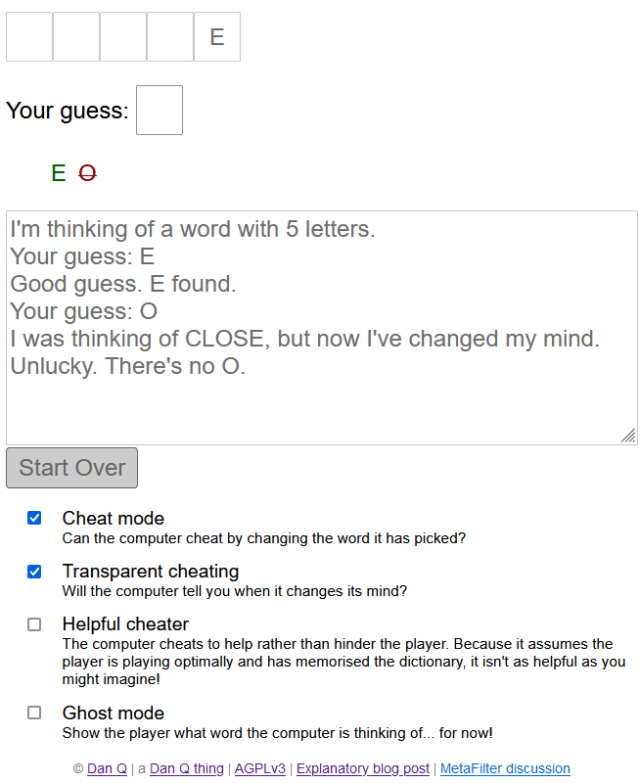
I can simplify, I figured. So I did.
And in doing so, I rediscovered several old projects I’d neglected or forgotten about. I wonder if anybody’s still using any of them?
Hosting I’ve tidied so far…
- Cheating Hangman is now hosted by GitHub Pages.
- DNDle, my Wordle-clone where you have to guess the Dungeons & Dragons 5e monster’s stat block, is now hosted by GitHub Pages. Also, I fixed an issue reported a month ago that meant that I was reporting Giant Scorpions as having a WIS of 19 instead of 9.
- Abnib, which mostly reminds people of upcoming birthdays and serves as a dumping ground for any Abnib-related shit I produce, is now hosted by GitHub Pages.
- RockMonkey.org.uk, which doesn’t really do much any more, is now hosted by GitHub Pages.
- EGXchange, my implementation of a digital wallet for environmentally-friendly cryptocurrency EmmaGoldCoin, which I’ve written about before, is now hosted by GitHub Pages.
- Sour Grapes, the single-page promo for a (remote) murder mystery party I hosted during a COVID lockdown, is now hosted by GitHub Pages.
- A convenience-page for giving lost people directions to my house is now hosted by GitHub Pages.
- Dan Q’s Things is now automatically built on a schedule and hosted by GitHub Pages.
- Robin’s Improbable Blog, which spun out from 52 Reflect, wasn’t getting enough traffic to justify “proper” hosting so now it sits in a Docker container on my NAS.
- My μlogger server, which records my location based on pings from my phone, has also moved to my NAS. This has broken Find Dan Q, but I’m not sure if I’ll continue with that in its current form anyway.
- All of my various domain/subdomain redirects have been consolidated on, or are in the process of moving to, to a tiny Linode/Akamai instance. It’s a super simple plain Nginx server that does virtually nothing except redirect people – this is where I’ll park the domains I register but haven’t found a use for yet, in future.

It turns out GitHub pages is a fine place to host simple, static websites that were open-source already. I’ve been working on improving my understanding of GitHub Actions anyway as part of what I’ve been doing while wearing my work, volunteering, and personal hats, so switching some static build processes like DNDle’s to GitHub Actions was a useful exercise.
Stuff I’m still to tidy…
There’s still a few things I need to tidy up to bring my personal hosting situation under control:
DanQ.me
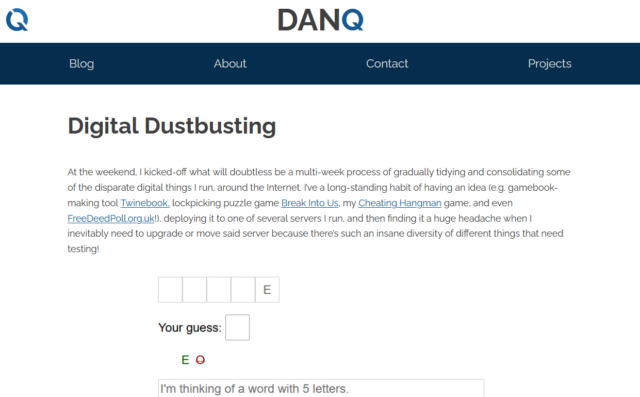
This is the big one, because it’s not just a WordPress blog: it’s also a Gemini, Spartan, and Gopher server (thanks CapsulePress!), a Finger server, a general-purpose host to a stack of complex stuff only some of which is powered by Bloq (my WordPress/PHP integrations): e.g. code to generate the maps that appear on my geopositioned posts, code to integrate with the Fediverse, a whole stack of configuration to make my caching work the way I want, etc.
FreeDeedPoll.org.uk
Right now this is a Ruby/Sinatra application, but I’ve got a (long-running) development branch that will make it run completely in the browser, which will further improve privacy, allow it to run entirely-offline (with a service worker), and provide a basis for new features I’d like to provide down the line. I’m hoping to get to finishing this during my Automattic sabbatical this winter.
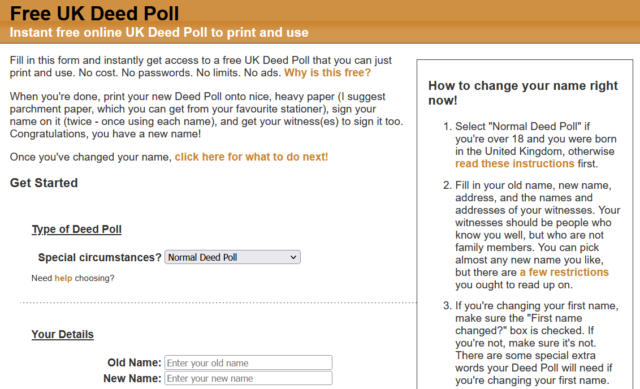
A secondary benefit of it becoming browser-based, of course, is that it can be hosted as a static site, which will allow me to move it to GitHub Pages too.
Geohashing.site
When I took over running the world’s geohashing hub from xkcd‘s Randall Munroe (and davean), I flung the site together on whatever hosting I had sitting around at the time, but that’s given me some headaches. The outbound email transfer agent is a pain, for example, and it’s a hard host on which to apply upgrades. So I want to get that moved somewhere better this winter too. It’s actually the last site left running on its current host, so it’ll save me a little money to get it moved, too!
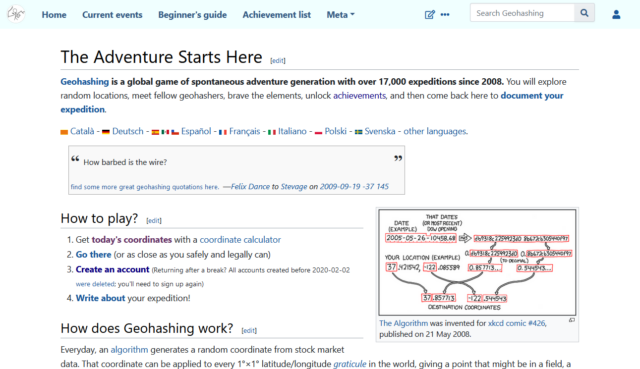
My FreshRSS instance
Right now I run this on my NAS, but that turns out to be a pain sometimes because it means that if my home Internet goes down (e.g. thanks to a power cut, which we have from time to time), I lose access to the first and last place I go on the Internet! So I’d quite like to move that to somewhere on the open Internet. Haven’t worked out where yet.
Next steps
It’s felt good so far to consolidate and tidy-up my personal web hosting (and to rediscover some old projects I’d forgotten about). There’s work still to do, but I’m expecting to spend a few months not-doing-my-day-job very soon, so I’m hoping to find the opportunity to finish it then!
D20 with Advantage
Dungeons & Dragons players spend a lot of time rolling 20-sided polyhedral dice, known as D20s.
In general, they’re looking to roll as high as possible to successfully stab a wyvern, jump a chasm, pick a lock, charm a Duke1, or whatever.
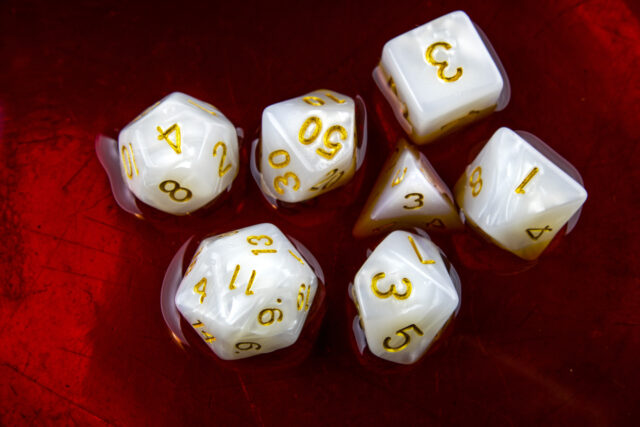
Roll with advantage
Sometimes, a player gets to roll with advantage. In this case, the player rolls two dice, and takes the higher roll. This really boosts their chances of not-getting a low roll. Do you know by how much?
I dreamed about this very question last night. And then, still in my dream, I came up with the answer2. I woke up thinking about it3 and checked my working.
| 1 | 2 | 3 | 4 | 5 | 6 | 7 | 8 | 9 | 10 | 11 | 12 | 13 | 14 | 15 | 16 | 17 | 18 | 19 | 20 | |
|---|---|---|---|---|---|---|---|---|---|---|---|---|---|---|---|---|---|---|---|---|
| 1 | 1 | 2 | 3 | 4 | 5 | 6 | 7 | 8 | 9 | 10 | 11 | 12 | 13 | 14 | 15 | 16 | 17 | 18 | 19 | 20 |
| 2 | 2 | 2 | 3 | 4 | 5 | 6 | 7 | 8 | 9 | 10 | 11 | 12 | 13 | 14 | 15 | 16 | 17 | 18 | 19 | 20 |
| 3 | 3 | 3 | 3 | 4 | 5 | 6 | 7 | 8 | 9 | 10 | 11 | 12 | 13 | 14 | 15 | 16 | 17 | 18 | 19 | 20 |
| 4 | 4 | 4 | 4 | 4 | 5 | 6 | 7 | 8 | 9 | 10 | 11 | 12 | 13 | 14 | 15 | 16 | 17 | 18 | 19 | 20 |
| 5 | 5 | 5 | 5 | 5 | 5 | 6 | 7 | 8 | 9 | 10 | 11 | 12 | 13 | 14 | 15 | 16 | 17 | 18 | 19 | 20 |
| 6 | 6 | 6 | 6 | 6 | 6 | 6 | 7 | 8 | 9 | 10 | 11 | 12 | 13 | 14 | 15 | 16 | 17 | 18 | 19 | 20 |
| 7 | 7 | 7 | 7 | 7 | 7 | 7 | 7 | 8 | 9 | 10 | 11 | 12 | 13 | 14 | 15 | 16 | 17 | 18 | 19 | 20 |
| 8 | 8 | 8 | 8 | 8 | 8 | 8 | 8 | 8 | 9 | 10 | 11 | 12 | 13 | 14 | 15 | 16 | 17 | 18 | 19 | 20 |
| 9 | 9 | 9 | 9 | 9 | 9 | 9 | 9 | 9 | 9 | 10 | 11 | 12 | 13 | 14 | 15 | 16 | 17 | 18 | 19 | 20 |
| 10 | 10 | 10 | 10 | 10 | 10 | 10 | 10 | 10 | 10 | 10 | 11 | 12 | 13 | 14 | 15 | 16 | 17 | 18 | 19 | 20 |
| 11 | 11 | 11 | 11 | 11 | 11 | 11 | 11 | 11 | 11 | 11 | 11 | 12 | 13 | 14 | 15 | 16 | 17 | 18 | 19 | 20 |
| 12 | 12 | 12 | 12 | 12 | 12 | 12 | 12 | 12 | 12 | 12 | 12 | 12 | 13 | 14 | 15 | 16 | 17 | 18 | 19 | 20 |
| 13 | 13 | 13 | 13 | 13 | 13 | 13 | 13 | 13 | 13 | 13 | 13 | 13 | 13 | 14 | 15 | 16 | 17 | 18 | 19 | 20 |
| 14 | 14 | 14 | 14 | 14 | 14 | 14 | 14 | 14 | 14 | 14 | 14 | 14 | 14 | 14 | 15 | 16 | 17 | 18 | 19 | 20 |
| 15 | 15 | 15 | 15 | 15 | 15 | 15 | 15 | 15 | 15 | 15 | 15 | 15 | 15 | 15 | 15 | 16 | 17 | 18 | 19 | 20 |
| 16 | 16 | 16 | 16 | 16 | 16 | 16 | 16 | 16 | 16 | 16 | 16 | 16 | 16 | 16 | 16 | 16 | 17 | 18 | 19 | 20 |
| 17 | 17 | 17 | 17 | 17 | 17 | 17 | 17 | 17 | 17 | 17 | 17 | 17 | 17 | 17 | 17 | 17 | 17 | 18 | 19 | 20 |
| 18 | 18 | 18 | 18 | 18 | 18 | 18 | 18 | 18 | 18 | 18 | 18 | 18 | 18 | 18 | 18 | 18 | 18 | 18 | 19 | 20 |
| 19 | 19 | 19 | 19 | 19 | 19 | 19 | 19 | 19 | 19 | 19 | 19 | 19 | 19 | 19 | 19 | 19 | 19 | 19 | 19 | 20 |
| 20 | 20 | 20 | 20 | 20 | 20 | 20 | 20 | 20 | 20 | 20 | 20 | 20 | 20 | 20 | 20 | 20 | 20 | 20 | 20 | 20 |
The chance of getting a “natural 1” result on a D20 is 1 in 20… but when you roll with advantage, that goes down to 1 in 400: a huge improvement! The chance of rolling a 10 or 11 (2 in 20 chance of one or the other) remains the same. And the chance of a “crit” – 20 – goes up from 1 in 20 when rolling a single D20 to 39 in 400 – almost 10% – when rolling with advantage.
You can see that in the table above: the headers along the top and left are the natural rolls, the intersections are the resulting values – the higher of the two.
The nice thing about the table above (which again: was how I visualised the question in my dream!) is it really helps to visualise why these numbers are what they are. The general formula for calculating the chance of a given number when rolling D20 with advantage is ( n2 – (n-1)2 ) / 400. That is, the square of the number you’re looking for, minus the square of the number one less than that, over 400 (the total number of permutations)4.
Why roll two dice when one massive one will do?
Knowing the probability matrix, it’s theoretically possible to construct a “D20 with Advantage” die5. Such a tool would have 400 sides (one 1, three 2s, five 3s… and thirty-nine 20s). Rolling-with-advantage would be a single roll.
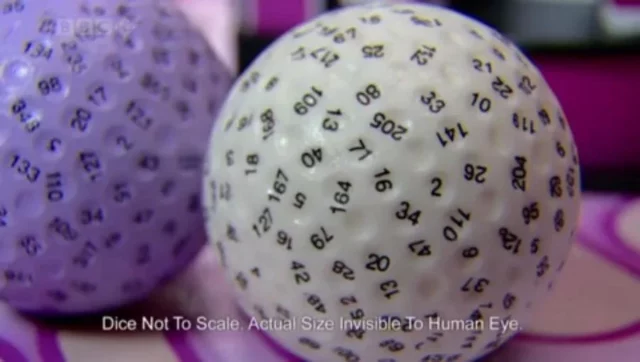
This is probably a totally academic exercise. The only conceivable reason I can think of would be if you were implementing a computer system on which generating random numbers was computationally-expensive, but memory was cheap: under this circumstance, you could pre-generate a 400-item array of possible results and randomly select from it.
But if anybody’s got a 3D printer capable of making a large tetrahectogon (yes, that’s what you call a 400-sided polygon – you learned something today!), I’d love to see an “Advantage D20” in the flesh. Or if you’d just like to implement a 3D model for Dice Box that’d be fine too!
Footnotes
1 Or throw a fireball, recall an anecdote, navigate a rainforest, survive a poisoning, sneak past a troll, swim through a magical swamp, hold on to a speeding aurochs, disarm a tripwire, fire a crossbow, mix a potion, appeal to one among a pantheon of gods, beat the inn’s landlord at an arm-wrestling match, seduce a duergar guard, persuade a talking squirrel to spy on some bandits, hold open a heavy door, determine the nature of a curse, follow a trail of blood, find a long-lost tome, win a drinking competition, pickpocket a sleeping ogre, bury a magic sword so deep that nobody will ever find it, pilot a spacefaring rowboat, interpret a forgotten language, notice an imminent ambush, telepathically commune with a distant friend, accurately copy-out an ancient manuscript, perform a religious ritual, find the secret button under the wizard’s desk, survive the blistering cold, entertain a gang of street urchins, push through a force field, resist mind control, and then compose a ballad celebrating your adventure.
2 I don’t know what it says about me as a human being that sometimes I dream in mathematics, but it perhaps shouldn’t be surprising given I’m nerdy enough to have previously recorded instances of dreaming in (a) Perl, and (b) Nethack (terminal mode).
3 When I woke up I also found that I had One Jump from Disney’s Aladdin stuck in my head, but I’m not sure that’s relevant to the discussion of probability; however, it might still be a reasonable indicator of my mental state in general.
4 An alternative formula which is easier to read but harder to explain would be ( 2(n – 1) + 1 ) / 400.
5 Or a “D20 with Disadvantage”: the table’s basically the inverse of the advantage one – i.e. 1 in 400 chance of a 20 through to 39 in 400 chance of a 1.
Multi-Phase Maps in FoundryVTT
FoundryVTT is a fantastic Web-based environment for tabletop roleplaying adventures1 and something I particularly enjoy is the freedom for virtually-unlimited scripting. Following a demonstration to a fellow DM at work last week I promised to throw together a quick tutorial into scripting simple multi-phase maps using Foundry.2
Why multi-phase maps?
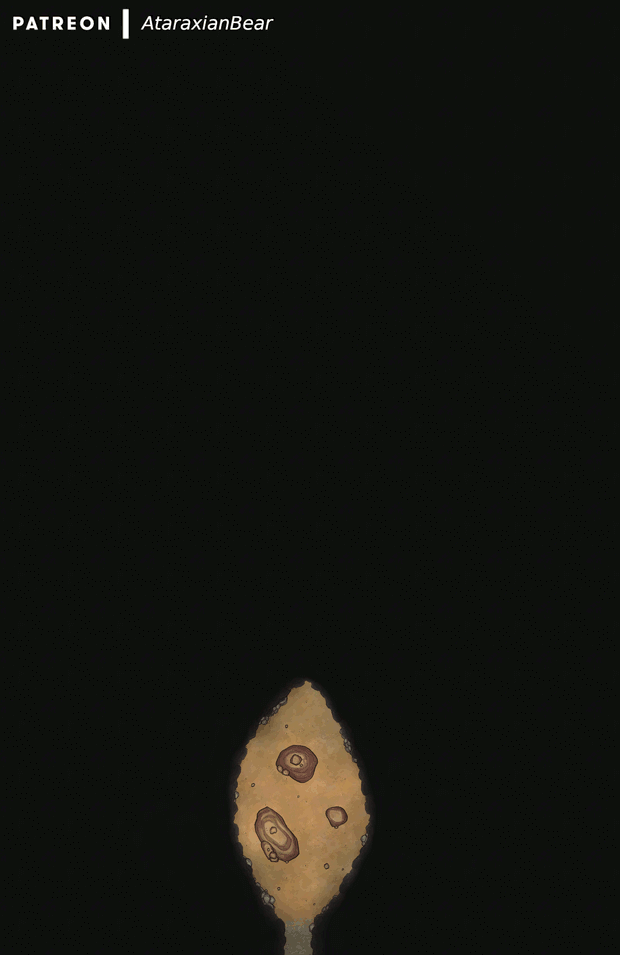
You might use a multi-phase map to:
- Allow the development and expansion of a siege camp outside the fortress where the heroes are holed-up.3
- Rotate through day and night cycles or different times of day, perhaps with different things to interact with in each.4
- Gradually flood a sewer with rising water… increasing the range of the monster that dwells within.5
- Re-arrange parts of the dungeon when the characters flip certain switches, opening new paths… and closing others.
I’ll use the map above to create a simple linear flow, powered by a macro in the hotbar. Obviously, more-complex scenarios are available, and combining this approach with a plugin like Monk’s Active Tile Triggers can even be used to make the map appear to dynamically change in response to the movement or actions of player characters!
Setting the scene
Create a scene, using the final state of the map as the background. Then, in reverse-order, add the previous states as tiles above it.
Make a note of the X-position that your tiles are in when they’re where they supposed to be: we’ll “move” the tiles off to the side when they’re hidden, to prevent their ghostly half-hidden forms getting in your way as game master. We’ll also use this X-position to detect which tiles have already been moved/hidden.
Also make note of each tile’s ID, so your script can reference them. It’s easiest to do this as you go along. When you’re ready to write your macro, reverse the list, because we’ll be hiding each tile in the opposite order from the order you placed them.
Writing the script
Next, create a new script macro, e.g. by clicking an empty slot in the macro bar. When you activate this script, the map will move forward one phase (or, if it’s at the end, it’ll reset).
Here’s the code you’ll need – the 👈 emoji identifies the places you’ll need to modify the code, specifically:
-
const revealed_tiles_default_x = 250should refer to the X-position of your tiles when they’re in the correct position. -
const revealed_tiles_modified_x = 2825should refer to the X-position they’ll appear at “off to the right” of your scene. To determine this, just move one tile right until it’s sufficiently out of the way of the battlemap and then check what it’s X-position is! Or just take the default X-position, add the width of your map in pixels, and then add a tiny bit more. -
const revealed_tiles = [ ... ]is a list of the tile IDs of each tile what will be hidden, in turn. In my example there are five of them (the sixth and final image being the scene background).
const revealed_tiles_default_x = 250; // 👈 X-position of tiles when displayed const revealed_tiles_modified_x = 2825; // 👈 X-position of tiles when not displayed const revealed_tiles = [ '2xG7S8Yqk4x1eAdr', // 👈 list of tile IDs in order that they should be hidden 'SjNQDBImHvrjAHWX', // (top to bottom) 'tuYg4FvLgIla1l21', 'auX4sj64PWmkAteR', 'yAL4YP0I4Cv4Sevt', ].map(t=>canvas.tiles.get(t)); /*************************************************************************************************/ // Get the topmost tile that is still visible: const next_revealed_tile_to_move = revealed_tiles.find(t=> t.position.x == revealed_tiles_default_x ); // If there are NO still-visible tiles, we must need to reset the map: if( ! next_revealed_tile_to_move ) { // To reset the map, we go through each tile and put it back where it belongs - for(tile of revealed_tiles){ canvas.scene.updateEmbeddedDocuments("Tile", [ { _id: tile.id, x: revealed_tiles_default_x, hidden: false } ]); } } else { // Otherwise, hide the topmost visible tile (and move it off to the side to help the GM) - canvas.scene.updateEmbeddedDocuments("Tile", [ { _id: next_revealed_tile_to_move.id, x: revealed_tiles_modified_x, hidden: true } ]); }
I hope that the rest of the code is moderately self-explanatory for anybody with a little JavaScript experience, but if you’re just following this kind of simple, linear case then you don’t need to modify it anyway. But to summarise, what it does is:
- Finds the first listed tile that isn’t yet hidden (by comparing its X-position to the pre-set X-position).
- If there aren’t any such tiles, we must have hidden them all already, so perform a reset: to do this – iterate through each tile and set its X-position to the pre-set X-position, and un-hide it.
- Otherwise, move the first not-hidden tile to the alternative X-position and hide it.
I hope you have fun with scripting your own multi-phase maps. Just don’t get so caught-up in your awesome scenes that you fail to give the players any agency!
Footnotes
1 Also, it’s on sale at 20% off this week to celebrate its fourth anniversary. Just sayin’.
2 I can neither confirm nor deny that a multi-phase map might be in the near future of The Levellers‘ adventure…
3 AtraxianBear has a great series of maps inspired by the 1683 siege of Vienna by the Ottomans that could be a great starting point for a “gradually advancing siege” map.
4 If you’re using Dungeon Alchemist as part of your mapmaking process you can just export orthographic or perspective outputs with different times of day and your party’s regular inn can be appropriately lit for any time of day, even if the party decides to just “wait at this table until nightfall”.
5 Balatro made a stunning map with rising water as a key feature: there’s a preview available.
Let Your Players Lead The Way
I’ve been GMing/DMing/facilitating1 roleplaying games for nearby 30 years, but I only recently began to feel like I was getting to be good at it.
The secret skill that was hardest for me to learn? A willingness to surrender control to the players.
Karma, Drama, Fortune
I could write a lot about the way I interpret the K/D/F model, but for today here’s a quick primer:
The K/D/F model describes the relationship between three forces: Karma (player choices), Drama (story needs) and Fortune (luck, e.g. dice rolls). For example,
- When the lich king comes to the region to provide a villainous plot hook, that’s Drama. Nobody had to do anything and no dice were rolled. The story demanded a “big bad” and so – within the limitations of the setting – one turned up.
- When his lucky critical hit kills an ally of the adventurers, that’s Fortune. That battle could have gone a different way, but the dice were on the villain’s side and he was able to harm the players. When we don’t know which way something will go, and it matters, we hit the dice.
- When one of the heroes comes up with a clever way to use a magical artefact from a previous quest to defeat him, that’s Karma. It was a clever plan, and the players were rewarded for their smart choices by being able to vanquish the evil thing.
- And elsewhere on their quest they probably saw many other resolutions. Each of those may have leaned more-heavily on one or another of the three pillars, or balanced between them equally.
Disbalancing drama
For most of my many years of gamemastering, I saw my role as being the sole provider the “drama” part of the K/D/F model. The story comes from me, the choices and dice rolls come from the players, right?
Nope, I was wrong. That approach creates an inevitable trend, whether large or small, towards railroading: “forcing” players down a particular path.
A gamemaster with an inflexible and excessively concrete idea of the direction that a story must go will find that they become unable to see the narrative through any other lens. In extreme examples, the players are deprotagonised and the adventure just becomes a series of set pieces, connected by the gamemaster’s idea of how things should play out. I’ve seen this happen. I’ve even caused it to happen, sometimes.2
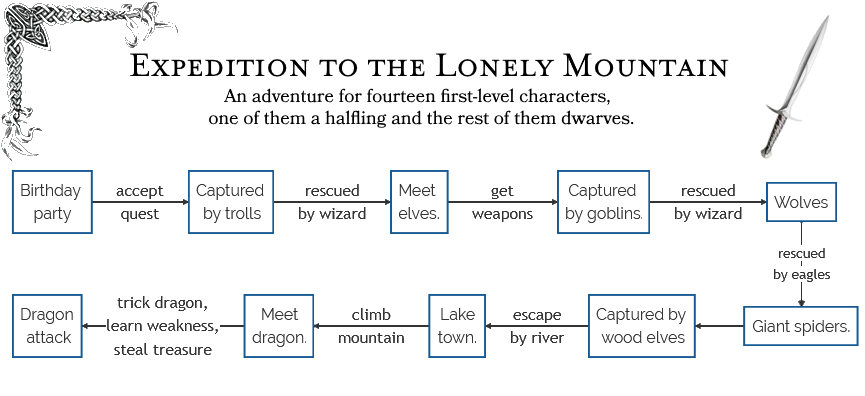
A catalogue of failures
I’ve railroaded players to some degree or another on an embarrassing number of occasions.
In the spirit of learning from my mistakes, here are three examples of me being a Bad GM.
Quantum Ogre
Scenario: In a short-lived high fantasy GURPS campaign, I wanted the party to meet a band of gypsies and have their fortune told, in order to foreshadow other parts of the story yet to come.
What I did: I pulled a quantum ogre (magician’s choice) on them: whether they travelled by road, or water, or hacked their way through the forest, they were always going to meet the gypsies: their choice of route didn’t really matter.
Why that was wrong: I’d elevated the value of the encounter I’d planned higher than the importance of player agency. The more effort it took to write something, the more I felt the need to ensure it happened!
Two things I could’ve done: Reassessed the importance of the encounter. Found other ways to foreshadow the plot that didn’t undermine player choices, and been more-flexible about my set pieces.
Fudging
Scenario: In a Spirit of the Century one-shot an antagonist needed to kidnap a NPC from aboard an oceanbound ship. To my surprise – with some very lucky rolls – the players foiled the plot!
What I did: I used a fudge – an exploit based on the fact that in most games the gamemaster controls both the plot and the hidden variables of the game mechanics – to facilitate the antagonist kidnapping a different NPC, and adapted the story to this new reality.
Why that was wrong: It made the players feel like their choices didn’t matter. I justified it to myself by it being a one-shot, but that undermines the lesson: I could’ve done better.
Two things I could’ve done: Used the failed attack as a precursor to a later renewed offensive by a villain who’s now got a personal interest in seeing the party fail. Moved towards a different story, perhaps to a different element of the antagonist’s plan.
Ex Machina
Scenario: In a long-running Warhammer Fantasy Roleplay (1st edition!) campaign, a series of bad choices and terrible luck left the party trapped and unable to survive the onslaught of a literal army of bloodthirsty orcs.
What I did: I whipped out a deus spiritus ex machina, having a friendly ghost NPC
basically solve for them a useful puzzle they’d been struggling with, allowing them to escape alive (albeit with the quest truly failed).
Why that was wrong: It deprotagonised the adventurers, making them unimportant in their own stories. At the time, I felt that by saving the party I was “saving” the game, but instead I was undermining its value.
Two things I could’ve done: TPK: sometimes it’s the right thing to allow everybody to die! Pivot the plot to facilitate their capture (e.g. the arch-nemesis can’t solve the puzzle either and wants to coerce them into helping), leading to new challenges and interesting moral choices.
Those examples are perhaps extreme, but I’m pretty sure I’ve set up my fair share of lesser sins too. Like chokepoints that strongly encourage a particular direction: do that enough and you train your players to wait until they identify the chokepoint before they take action! Or being less invested in players’ plans if those plans deviate from what I anticipated, and having a convenient in-party NPC prompting players with what they ought to do next. Ugh.3
The good news is, of course, that we’ve all always got the opportunity for growth and self-improvement.
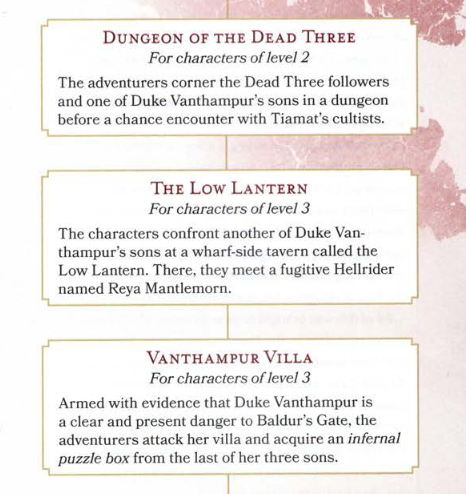
The self-improvement path
I’ve gotten better at this in general over the years, but when I took over from Simon at DMing for The Levellers in July, I decided that I was going to try to push myself harder than ever to avoid railroading. Simon was always especially good at promoting player freedom and autonomy, and I wanted to use this inspiration as a vehicle to improve my own gamemastering.
What does that look like within the framework of an established campaign?
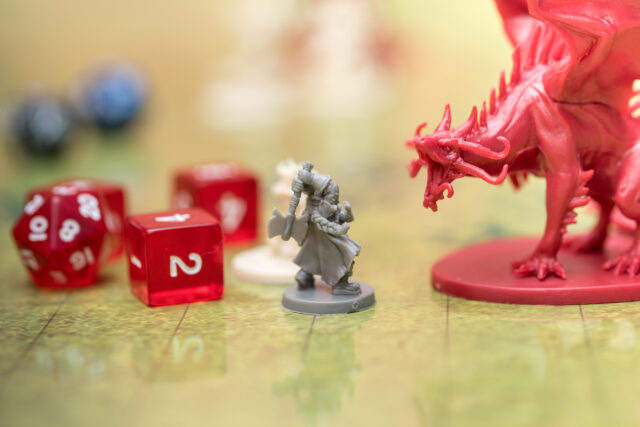
Well: I ensure there are clues (usually three of them!) to point the players in the “right” direction. And I’ll be on hand to give “nudges” if they’re truly stuck for what to do next, typically by providing a “recap” of the things they’ve previously identified as hooks that are worth following-up (including both the primary plotline and any other avenues they’ve openly discussed investigating).
But that’s the limit to how I allow Drama to control the direction of the story. Almost everything else lies in the hands of Karma and Fortune.
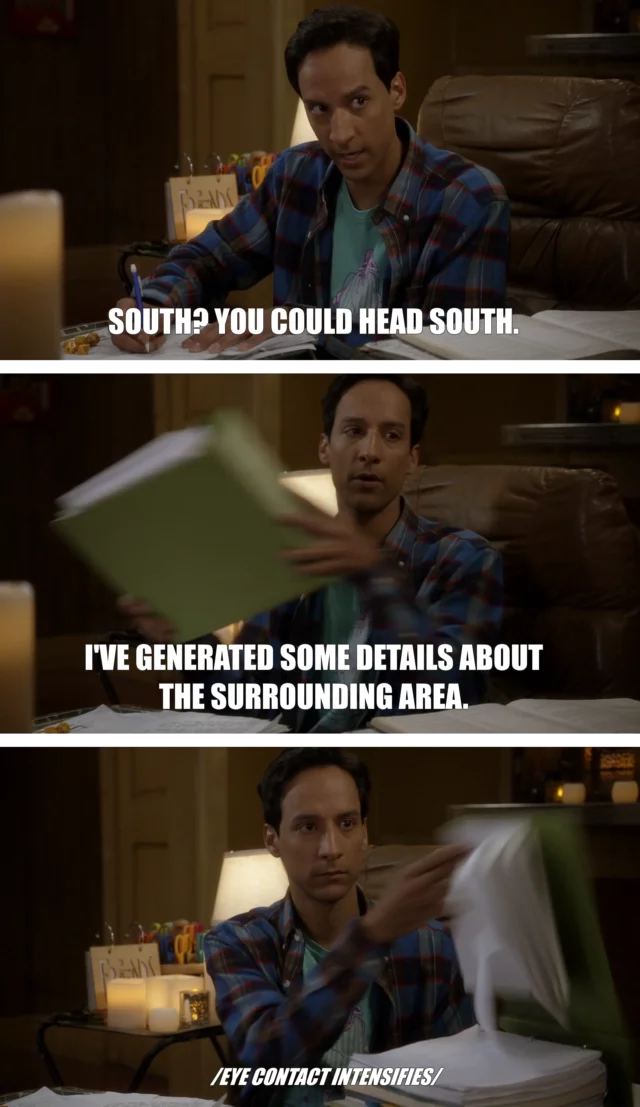
Needless to say, opening up the possibility space for my players makes gamemastering harder4! But… not by as much as I expected. Extra prep-work was necessary, especially at the outset, in order to make sure that the world I was inheriting/building upon was believable and internally-consistent (while ensuring that if a player decided to “just keep walking East” they wouldn’t fall off the edge of the world). But mostly, the work did itself.
Because here’s the thing I learned: so long as you’re willing to take what your players come up with and run with it, they’ll help make the story more compelling. Possibly without even realising it.5
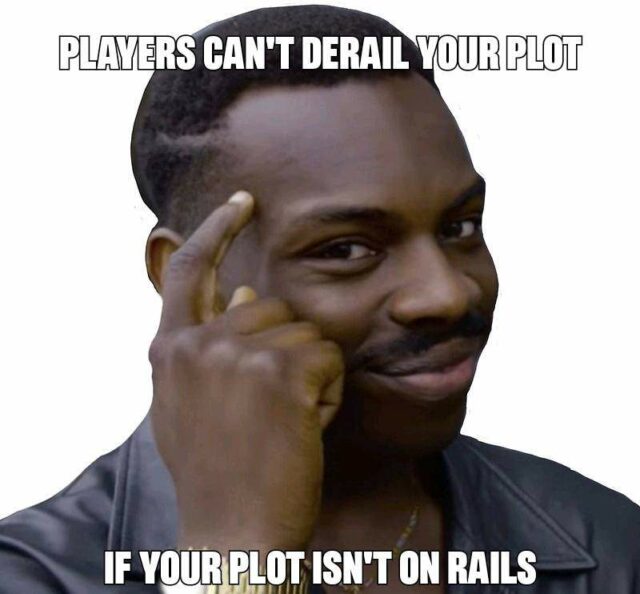
The Levellers are a pretty special group. No matter what the situation, they can always be relied upon to come up with a plan that wasn’t anywhere on their DM‘s radar. When they needed to cross a chasm over their choice of one of two bridges, each guarded by a different variety of enemy, I anticipated a few of the obvious options on each (fighting, magic, persuasion and intimidation, bribery…) but a moment later they were talking about having their druid wildshape into something easy-to-carry while everybody else did a group-spider climb expedition down the chasm edge and along the underside of a bridge. That’s thinking outside the box!
But the real magic has come when the party, through their explorations, have unlocked entirely new elements of the story.
Player-driven content
In our campaign, virtually all of the inhabitants of a city have inadvertently sold their immortal souls to a Archduchess of Hell by allowing, over generations, their declaration of loyalty to their city to become twisted away from their gods and towards their mortal leader, who sold them on in exchange for a sweet afterlife deal. The knights of the city were especially-impacted, as the oath they swore upon promised their unending loyalty in this life as well. When the fiendish pact was made, these knights were immediately possessed by evil forces, transforming into horrendous creatures (who served to harass the party for some time).
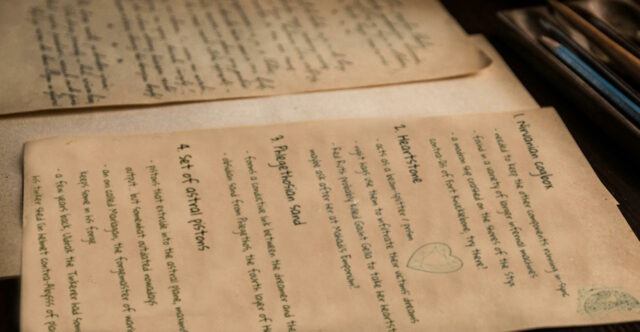
I didn’t have answers to these questions to begin with, but the players were moving towards investigating, so I provided some. This also opened up an entire new possible “soft” quest hook related to the reason for the discrepancy. So just like that, a plothole is discovered and investigated by a player, and that results in further opportunities for adventure.
As it happens, the party didn’t even go down that route at all and instead pushed-on in their existing primary direction, but the option remains. All thanks to player curiosity, there’s a possible small quest that’s never been written down or published, and is unique to our group and the party’s interests. And that’s awesome.
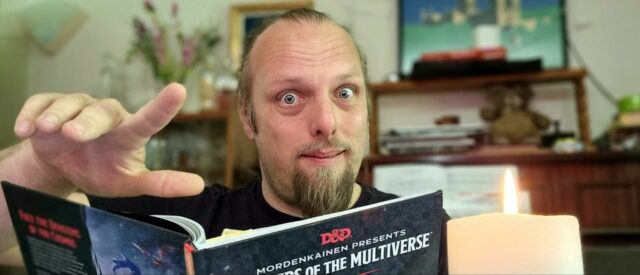
In Conclusion
I’m not the best GM in the world. I’m not even the best GM I know. But I’m getting better all the time; learning lessons like how to release the reins a little bit and see where my players can take our adventures.
And for those lessons, I’m grateful to those same players.
Footnotes
1 I’m using the terms GM, DM, and facilitator interchangeably, and damned if I’m writing them all out every single time.
2 A gamemaster giving all of the narrative power to any one of the three elements of K/D/F breaks the game, but in different ways. 100% karma and what you’ve got is a storytelling game, not a roleplaying game: which is fine if that’s what everybody at the table thinks they’re playing: otherwise not. 100% drama gives you a recital, not a jam session: the gamemaster might as well just be writing a book. 100% fortune leads to unrealistic chaos: with no rules to the world (either from the plot or from the consequences of actions) you’re just imagining all possible outcomes in your universe and picking one at random. There’s a balance, and where it sits might vary from group to group, but 100% commitment to a single element almost always breaks things.
3 A the “lesser sins” I mention show, the edges of what construes railroading and what’s merely “a linear quest” is a grey area, and where the line should be drawn varies from group to group. When I’m running a roleplaying session for my primary-school-aged kids, for example, I’m much more-tolerant of giving heavy-handed nudges at a high-level to help them stay focussed on what their next major objective was… but I try harder than ever to encourage diverse and flexible problem-solving ideas within individual scenes, where childish imagination can really make for memorable moments. One time, a tabaxi warrior, on fire, was falling down the outside of a tower… but his player insisted that he could shout a warning through the windows he passed before landing in flawless catlike fashion (albeit mildly singed). My adult players would be rolling athletics checks to avoid injury, but my kids? They can get away with adding details like that by fiat. Different audience, see?
4 A recent session took place after a hiatus, and I wasn’t confident that – with the benefit of a few months’ thinking-time – the party would continue with the plan they were executing before the break. And they didn’t! I’d tried to prep for a few other eventualities in the anticipation of what they might do and… I guessed wrong. So, for the first time in recorded history, our session ended early. Is that the end of the world? Nope.
5 Want a really radical approach to player-driven plot development? Take a look at this video by Zee Bashew, which I’m totally borrowing from next time I start running a new campaign.
6 You know what I miss? Feelies. That’s probably why I try to provide so many “props”, whether physical or digital, in my adventures.
7 The plothole isn’t even my fault, for once: it’s functionally broken as-delivered in the source book, although that matters little because we’ve gone so-far outside the original source material now we’re on a whole different adventure, possibly to reconvene later on.
[Bloganuary] Playtime
This post is part of my attempt at Bloganuary 2024. Today’s prompt is:
Do you play in your daily life? What says “playtime” to you?
How do I play? Let me count the ways!
RPGs
I’m involved in no fewer than three different RPG campaigns (DMing the one for The Levellers) right now, plus periodic one-shots. I love a good roleplaying game, especially one that puts character-building and storytelling above rules-lawyering and munchkinery, specifically because that kind of collaborative, imaginative experience feels more like the kind of thing we call “play” when done it’s done by children!
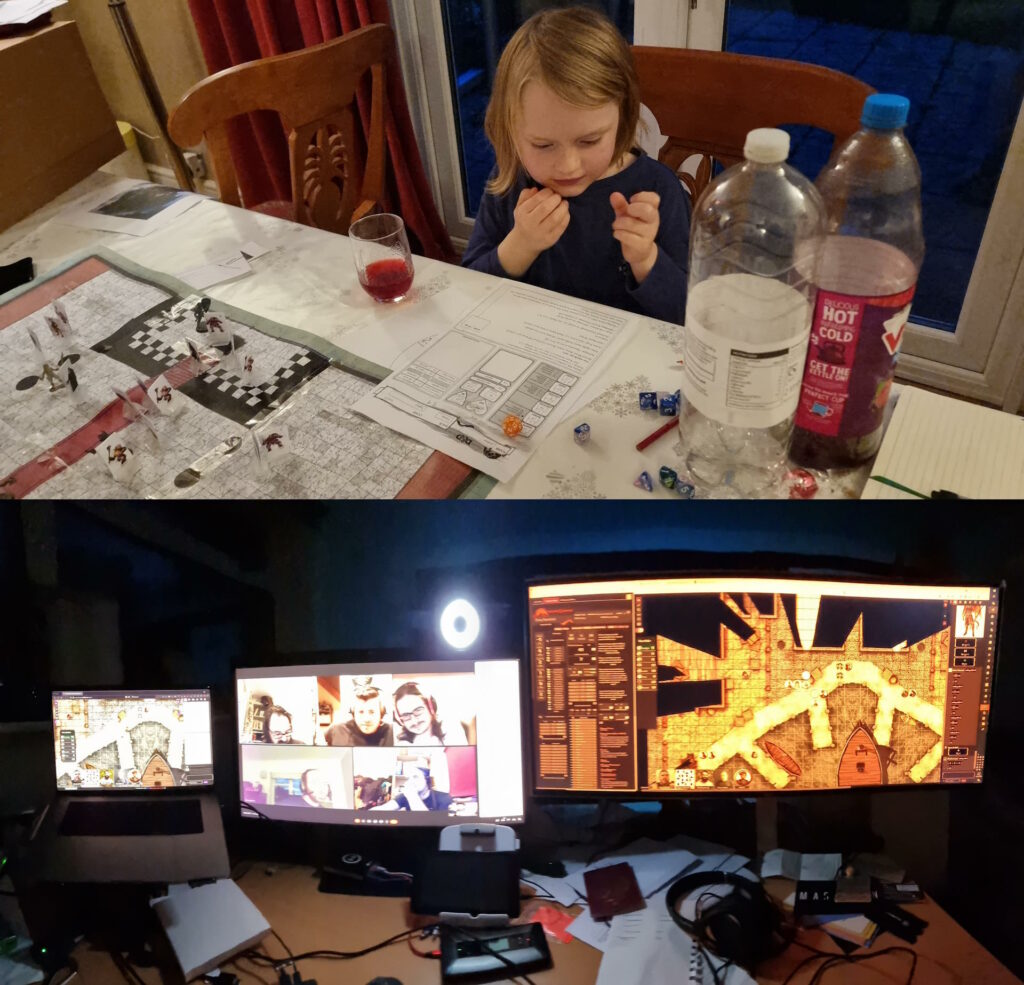
Videogames
I don’t feel like I get remotely as much videogaming time as I used to, and in theory I’ve become more-selective about exactly what I spend my time on1.
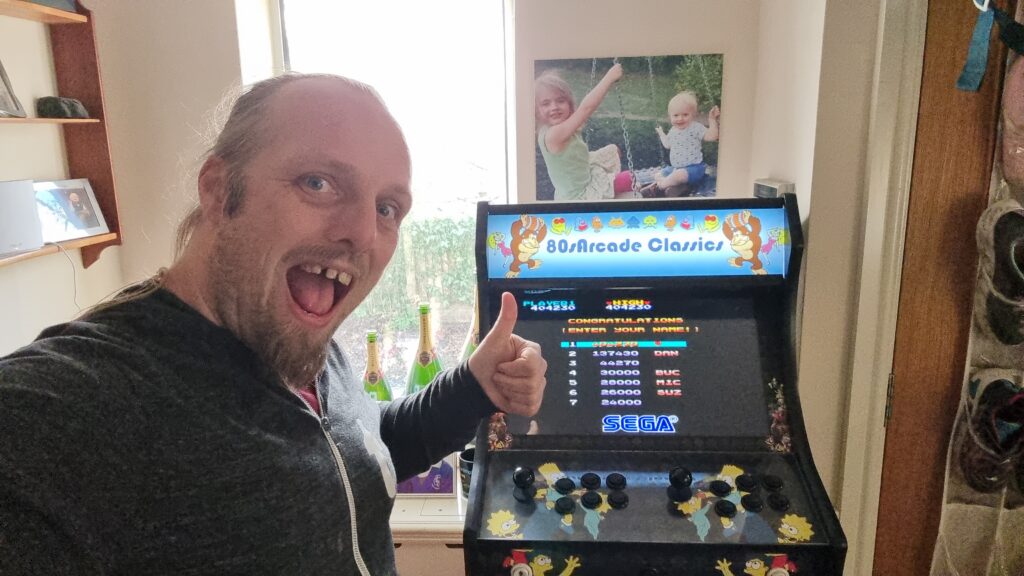
Board Games
Similarly, I don’t feel like I get as much time to grind through my oversized board games collection as I used to2, but that’s improving as the kids get older and can be roped-into a wider diversity of games3.
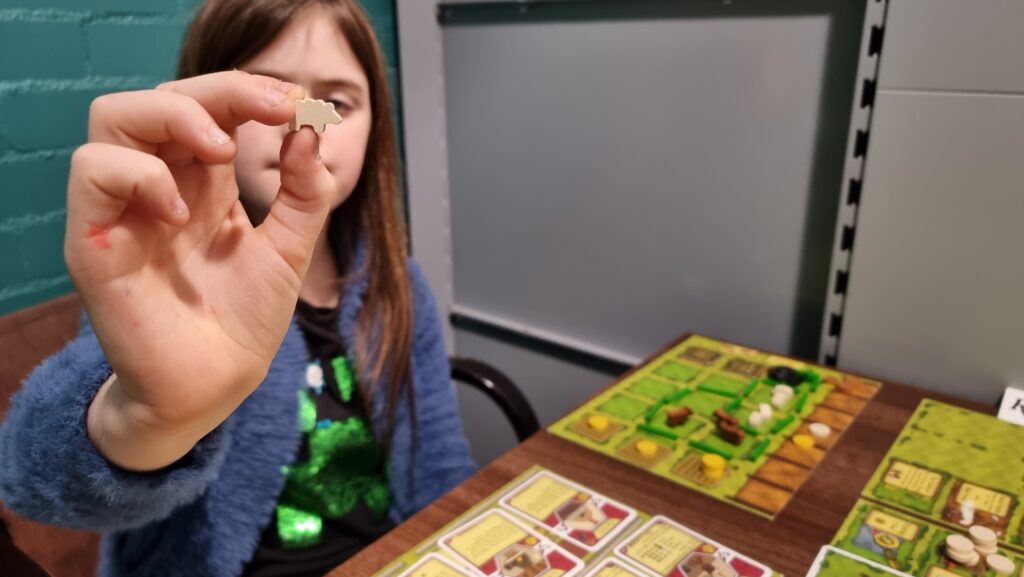
Escape Rooms
I love a good escape room, and I can’t wait until the kids are old enough for (more of) them too so I’ve an excuse to do more of them. When we’re not playing conventional escape rooms, Ruth and I can sometimes be found playing board game-style boxed “kit” ones (which have very variable quality, in my experience) and we’ve recently tried a little Escape Academy.
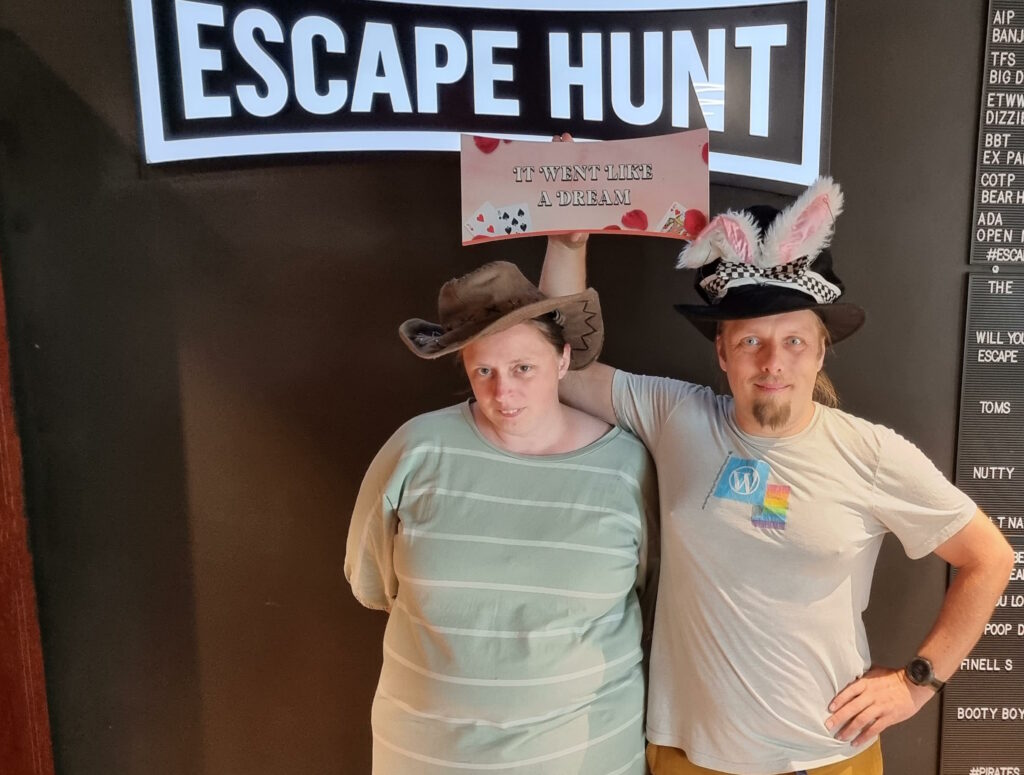
GNSS Activities
I’m sure everybody knows I do a modest amount of geocaching and geohashing.4
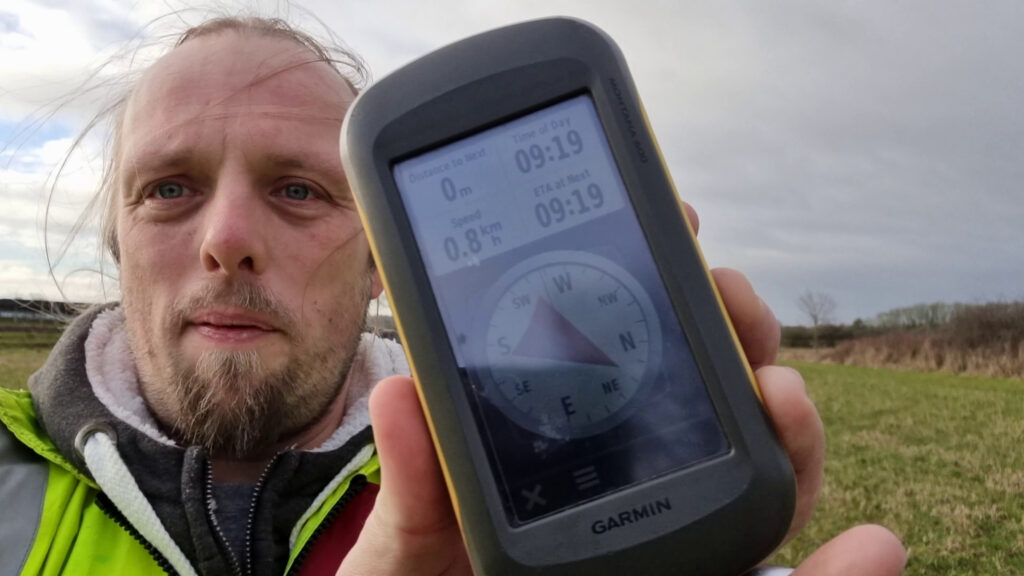
They’re not the only satnav-based activities I do at least partially “for fun” though! I contribute to OpenStreetMap, often through the “gamified” experience of the StreetComplete app, and I’m very slowly creeping up the leader board at OpenBenches. Are these “play”? Sure, maybe.
And all of the above is merely the structured kinds of play I engage in. Playing “let’s pretend”-style games with the kids (even when they make it really, really weird) adds a whole extra aspect. Also there’s the increasingly-rare murder mystery parties we sometimes hold: does that count as roleplaying, or some other kind of play?

Suffice to say, there’s plenty of play in my life, it’s quite varied and diverse, and there is, if anything, not enough of it!
Footnotes
1 I say that, and yet somehow Steam tells me that one of my most-played games this year was Starfield, which was… meh? Apparently compelling enough that I’ve “ascended” twice, but in hindsight I wish I hadn’t bothered.
2 Someday my group and I will finish Pandemic Legacy: Season 2 so we can get started on Season 0 which has sat unplayed on my shelves since I got it… oooh… two or three years ago‽
3 This Christmas, I got each of them their first “legacy” game: Zombie Kids for the younger one, My City for the elder. They both seem pretty good.
4 Geocaching is where you use military satellite networks to find lost tupperware. Geohashing uses the same technology but what you find is a whole lot of nothing. I don’t think I can explain why I find the latter more-compelling.
Bramble
Easy FoundryVTT Cloud Hosting
Foundry is a wonderful virtual tabletop tool well-suited to playing tabletop roleplaying games with your friends, no matter how far away they are. It compares very favourably to the market leader Roll20, once you get past some of the initial set-up challenges and a moderate learning curve.
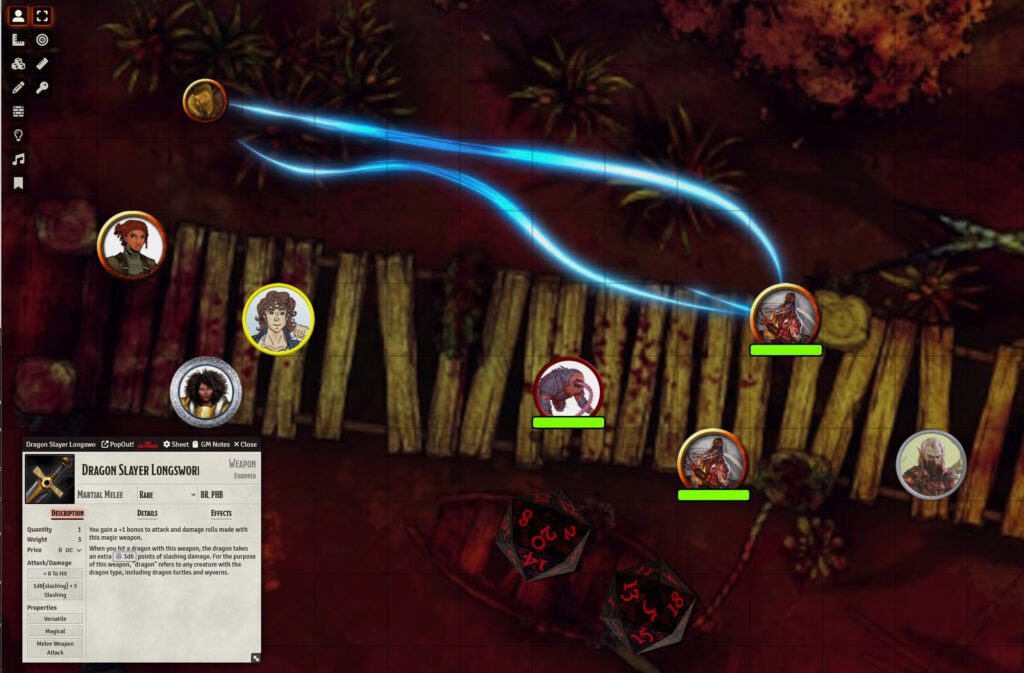
You can run it on your own computer and let your friends “connect in” to it, so long as you’re able to reconfigure your router a little, but you’ll be limited by the speed of your home Internet connection and people won’t be able to drop in and e.g. tweak their character sheet except when you’ve specifically got the application running.
A generally better option is to host your Foundry server in the cloud. For most of its history, I’ve run mine on Fox, my NAS, but I’ve recently set one up on a more-conventional cloud virtual machine too. A couple of friends have asked me about how to set up their own, so here’s a quick guide:

You will need…
- A Foundry license ($50 USD / £48 GBP, one-off payment1)
- A domain name for which you control the DNS records; you’ll need to point a domain, like “danq.me” (or a subdomain of it, e.g. “vtt.danq.me”), at an IP address you’ll get later by creating an “A” record: your domain name registrar can probably help with this – I mostly use Gandi and, ignoring my frustration with recent changes to their email services, I think they’re great
- An account with a cloud hosting provider: this example uses Linode but you can adapt for any of them
- A basic level of comfort with the command-line
1. Spin up a server
Getting a virtual server is really easy nowadays.
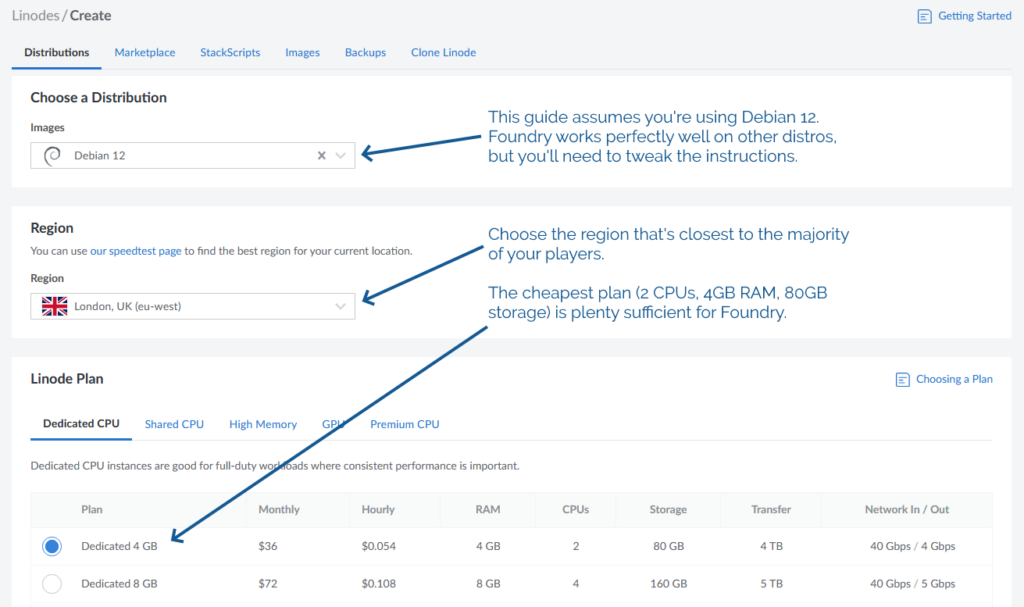
You’ll need:
- The operating system to be Debian 12 (or else you’ll need to adapt the instructions below)
- The location to be somewhere convenient for your players: pick a server location that’s relatively-local to the majority of them to optimise for connection speeds
- Approximately 2 CPUs and 4GB of RAM, per Foundry’s recommended server specifications
- An absolute minimum of 1GB of storage space, I’d recommend plenty more: The Levellers’ campaign currently uses about 10GB for all of its various maps, art, videos, and game data, so give yourself some breathing room (space is pretty cheap) – I’ve gone with 80GB for this example, because that’s what comes as standard with the 2 CPU/4GB RAM server that Linode offer
Choose a root password when you set up your server. If you’re a confident SSH user, add your public key so you can log in easily (and then disable password authentication entirely!).
For laziness, this guide has you run Foundry as root on your new server. Ensure you understand the implications of this.2
2. Point your (sub)domain at it
DNS propogation can be pretty fast, but… sometimes it isn’t. So get this step underway before you need it.
Your newly-created server will have an IP address, and you’ll be told what it is. Put that IP address into an A-record for your domain.
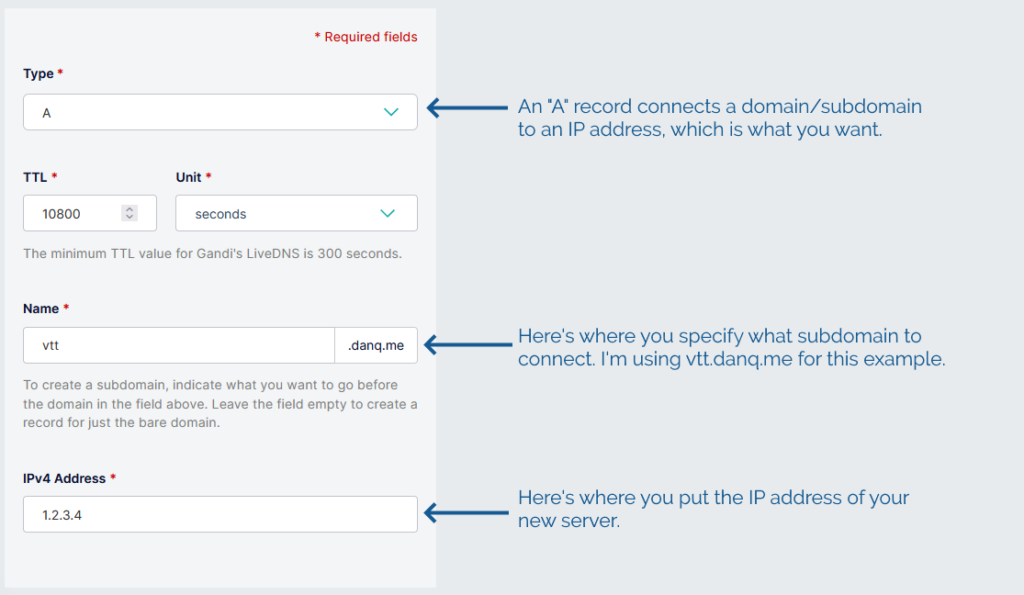
3. Configure your server
In my examples, my domain name is vtt.danq.me and my server is at 1.2.3.4. Yours will be different!
Connect to your new server using SSH. Your host might even provide a web interface if you don’t have an SSH client installed: e.g. Linode’s “Launch LISH Console” button will do pretty-much exactly that for you. Log in as root using the password you chose
when you set up the server (or your SSH private key, if that’s your preference). Then, run each of the commands below in order (the full script is available as a single file if you
prefer).
3.1. Install prerequisites
You’ll need unzip (to decompress Foundry), nodejs (to run Foundry), ufw (a firewall, to prevent unexpected surprises), nginx (a
webserver, to act as a reverse proxy to Foundry), certbot (to provide a free SSL certificate for Nginx),
nvm (to install pm2) and pm2 (to keep Foundry running in the background). You can install them all like this:
apt update apt upgrade apt install -y unzip nodejs ufw nginx certbot nvm npm install -g pm2
3.2. Enable firewall
By default, Foundry runs on port 30000. If we don’t configure it carefully, it can be accessed directly, which isn’t what we intend: we want connections to go through the webserver (over https, with http redirecting to https). So we configure our firewall to allow only these ports to be accessed. You’ll also want ssh enabled so we can remotely connect into the server, unless you’re exclusively using an emergency console like LISH for this purpose:
ufw allow ssh ufw allow http ufw allow https ufw enable
3.3. Specify domain name
Putting the domain name we’re using into a variable for the remainder of the instructions saves us from typing it out again and again. Make sure you type your domain name (that you pointed to your server in step 2), not mine (vtt.danq.me):
DOMAIN=vtt.danq.me
3.4. Get an SSL certificate with automatic renewal
So long as the DNS change you made has propogated, this should Just Work. If it doesn’t, you might need to wait for a bit then try again.
certbot certonly --agree-tos --register-unsafely-without-email --rsa-key-size 4096 --webroot -w /var/www/html -d $DOMAIN
Don’t continue past this point until you’ve succeeded in getting the SSL certificate sorted.
The certificate will renew itself automatically, but you also need Nginx to restart itself whenever that happens. You can set that up like this:
printf "#!/bin/bash\nservice nginx restart\n" > /etc/letsencrypt/renewal-hooks/post/restart-nginx.sh chmod +x /etc/letsencrypt/renewal-hooks/post/restart-nginx.sh
3.5. Configure Nginx to act as a reverse proxy for Foundry
You can, of course, manually write the Nginx configuration file: just remove the > /etc/nginx/sites-available/foundry from the end of the printf line to see
the configuration it would write and then use/adapt to your satisfaction.
set +H
printf "server {\n listen 80;\n listen [::]:80;\n server_name $DOMAIN;\n\n # Redirect everything except /.well-known/* (used for ACME) to HTTPS\n root /var/www/html/;\n if (\$request_uri !~ \"^/.well-known/\") {\n return 301 https://\$host\$request_uri;\n }\n}\n\nserver {\n listen 443 ssl http2;\n listen [::]:443 ssl http2;\n server_name $DOMAIN;\n\n ssl_certificate /etc/letsencrypt/live/$DOMAIN/fullchain.pem;\n ssl_certificate_key /etc/letsencrypt/live/$DOMAIN/privkey.pem;\n\n client_max_body_size 300M;\n\n location / {\n # Set proxy headers\n proxy_set_header Host \$host;\n proxy_set_header X-Forwarded-For \$proxy_add_x_forwarded_for;\n proxy_set_header X-Forwarded-Proto \$scheme;\n\n # These are important to support WebSockets\n proxy_set_header Upgrade \$http_upgrade;\n proxy_set_header Connection \"Upgrade\";\n\n proxy_pass http://127.0.0.1:30000/;\n }\n}\n" > /etc/nginx/sites-available/foundry
ln -sf /etc/nginx/sites-available/foundry /etc/nginx/sites-enabled/foundry
service nginx restart
3.6. Install Foundry
3.6.1. Create a place for Foundry to live
mkdir {vtt,data}
cd vtt
3.6.2. Download and decompress it

Substitute in your Timed URL in place of <url from website> (keep the quotation marks – " –
though!):
wget -O foundryvtt.zip "<url from website>" unzip foundryvtt.zip rm foundryvtt.zip
3.6.3. Configure PM2 to run Foundry and keep it running
Now you’re finally ready to launch Foundry! We’ll use PM2 to get it to run automatically in the background and keep running:
pm2 start --name "Foundry" node -- resources/app/main.js --dataPath=/root/data
You can watch the logs for Foundry with PM2, too. It’s a good idea to take a quick peep at them to check it launched okay (press CTRL-C to exit):
pm2 logs 0
4. Start adventuring!
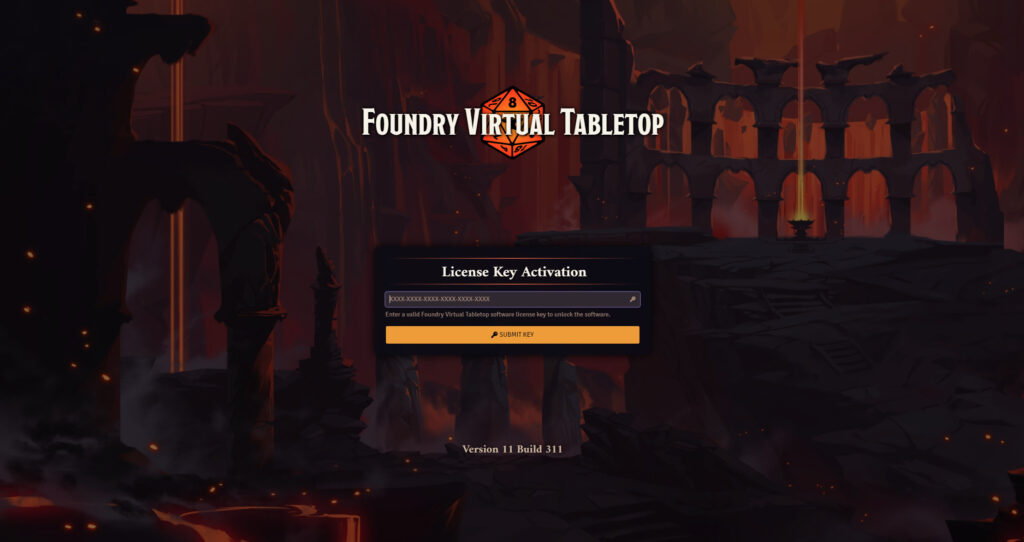
https://vtt.danq.me) and you should see Foundry’s first-load page, asking for your license key.
Provide your license key to get started, and then immediately change the default password: a new instance of Foundry has a blank default password, which means that anybody on Earth can administer your server: get that changed to something secure!
Now you’re running on Foundry!
Footnotes
1 Which currency you pay in, and therefore how much you pay, for a Foundry license depends on where in the world you are
where your VPN endpoint says you are. You might like to plan accordingly.
2 Running Foundry as root is dangerous, and you should consider the risks for yourself. Adding a new user is relatively simple, but for a throwaway server used for a single game session and then destroyed, I wouldn’t bother. Specifically, the risk is that a vulnerability in Foundry, if exploited, could allow an attacker to reconfigure any part of your new server, e.g. to host content of their choice or to relay spam emails. Running as a non-root user means that an attacker who finds such a vulnerability can only trash your Foundry instance.
Have Fun with Missions, Visions, and Values
I just spent a lightweight week in Rome with fellow members of Automattic‘s Team Fire.
Among our goals for the week was an attempt to strengthen the definition of who are team are, what we work on, and how and why we do so. That’s basically a team-level identity, mission, vision, and values, right?
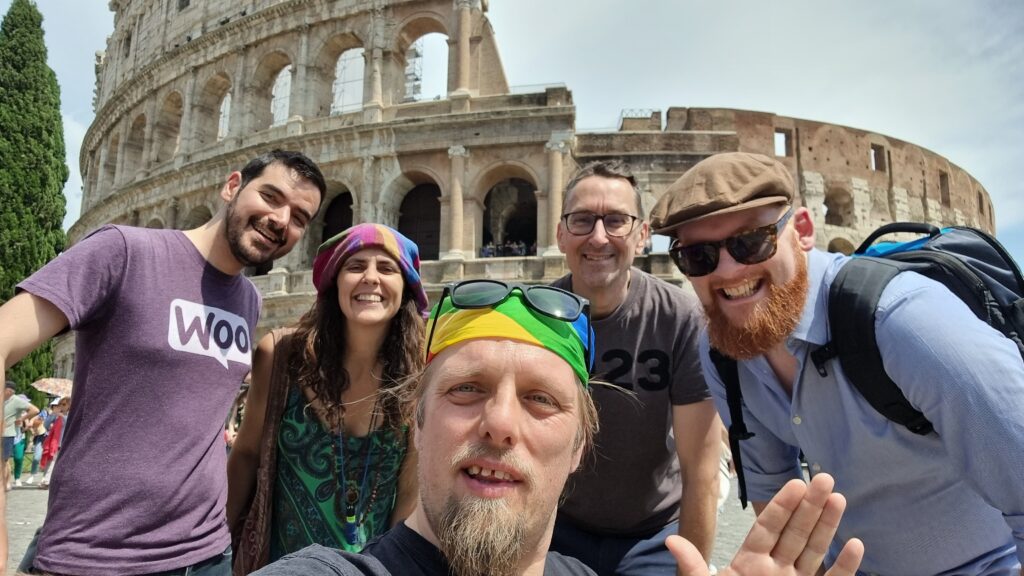
Fellow Automattician Ben Dwyer recently wrote about his experience of using a deck of Dixit cards to help his team refine their values in a fun and engaging way. I own a Dixit set, so we decided to give it a go too.
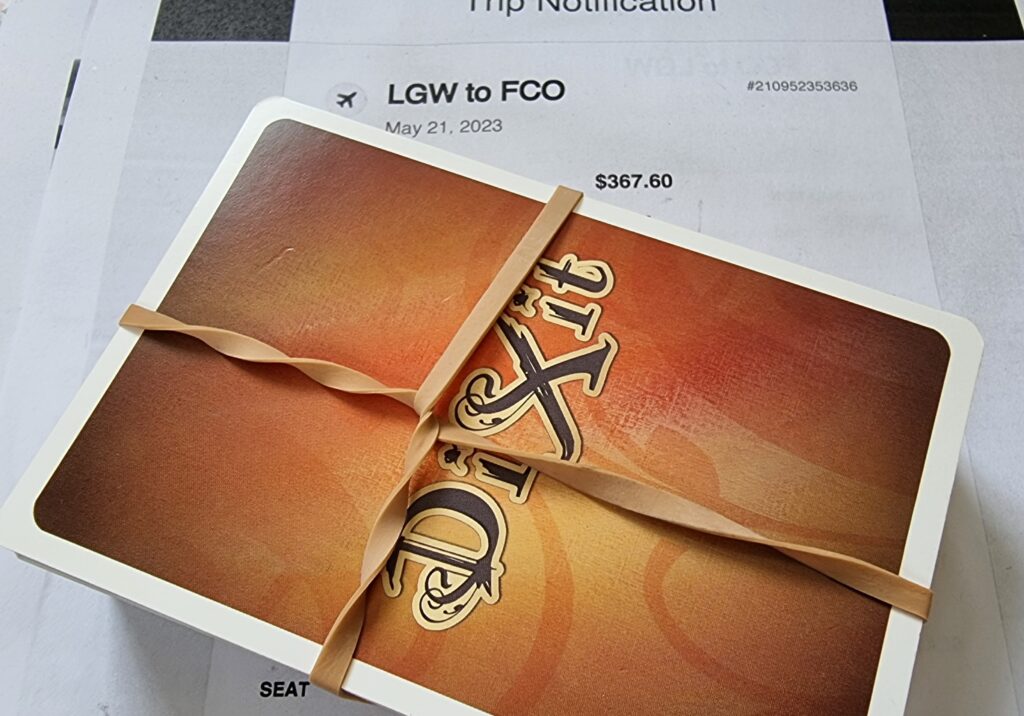
Normally when you play Dixit, you select a card from your hand – each shows a unique piece of artwork – and try to describe it in a way that’s precise enough that some of the other players will later be able to pick it out of a line-up, but ambiguous enough that not all the other players will. It’s a delicate balancing act. Even when our old Geek Night was in full swing we didn’t used to play it often because our well-established group’s cornucopia of in-jokes and references made it trivially easy to “target” your descriptions at specific players1, but it’s still a solid icebreaker activity.
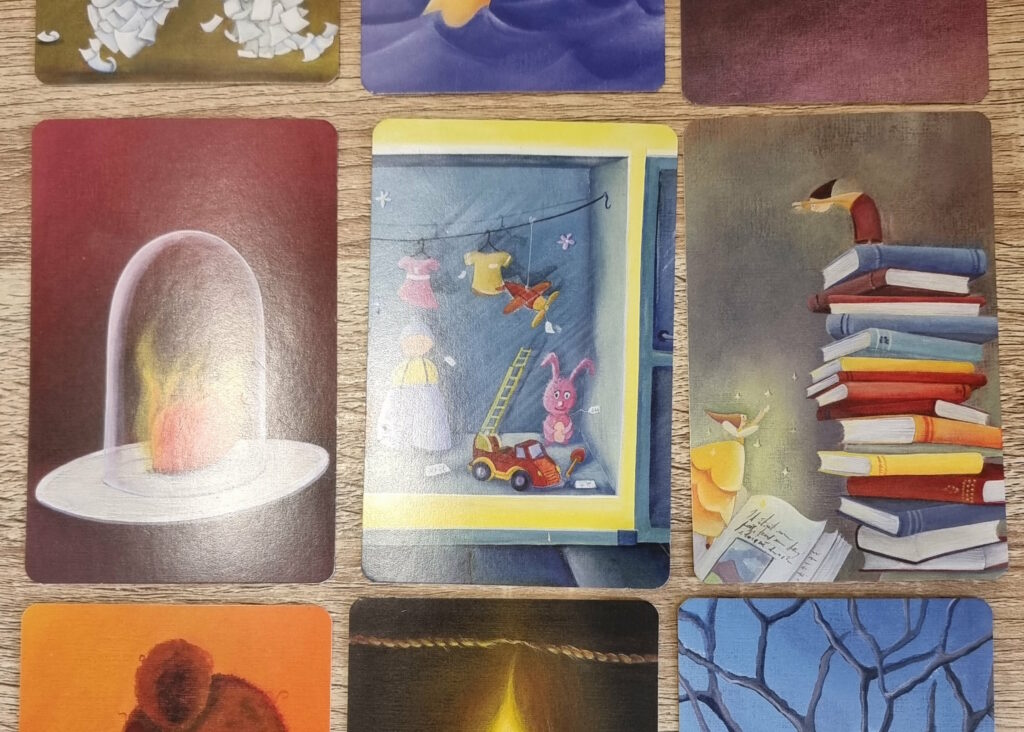
Perhaps it was the fantasy artwork that inspired us or maybe it just says something about how my team sees themselves, but what we came up with had a certain… swords-and-sorcery… even Dungeons & Dragons… feel to it.
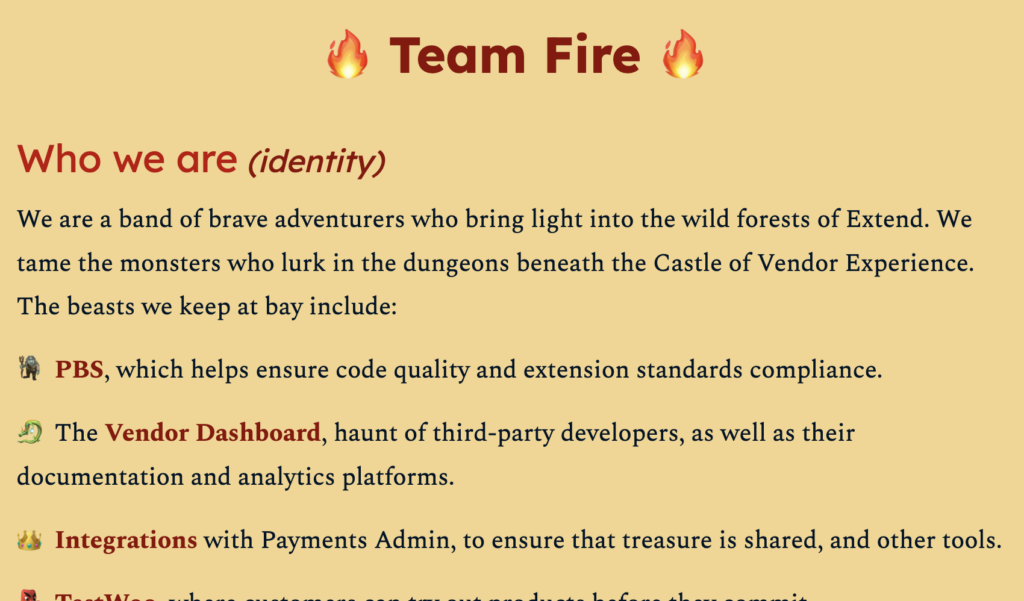
Ou team’s new identity isn’t finalised, but I love the fact that we’ve been able to inject a bit of fun and whimsy into it. At our last draft, my team looks to be defined as comprising:
- Gareth, level 62 Pathfinder, leading the way through the wilds
- Bero, Level 5 Battlesmith, currently lost in the void
- Dan (me!), Level 5 Arcane Trickster, breaking locks and stealing treasure
- Cem, Level 4 Dragonslayer, smashing doors and bugs alike
- Lae, Level 7 Pirate, seabound rogue with eyes on the horizon
- Kyle, Level 5 Apprentice Bard, master of words and magic
- Simran, Level 6 Apprentice Code Witch, weaving spells from nature
I think that’s pretty awesome.
Nightmares & Noggins
Last night I had a nightmare about Dungeons & Dragons. Specifically, about the group I DM for on alternate Fridays.
In their last session the party – somewhat uncharacteristically – latched onto a new primary plot hook rightaway. Instead of rushing off onto some random side quest threw themselves directly into this new mission.

This effectively kicked off a new chapter of their story, so I’ve been doing some prep-work this last week or so. Y’know: making battlemaps, stocking treasure chests with mysterious and powerful magical artefacts, and inventing a plethora of characters for the party to either befriend or kill (or, knowing this party: both).
Anyway: in the dream, I sat down to complete the prep-work I want to get done before this week’s play session. I re-checked my notes about what the adventurers had gotten up to last time around, and… panicked! I was wrong, they hadn’t thrown themselves off the side of a city floating above the first layer of Hell at all! I’d mis-remembered completely and they’d actually just ventured into a haunted dungeon. I’d been preparing all the wrong things and now there wasn’t time to correct my mistakes!

This is, of course, an example of the “didn’t prepare for the test” trope of dreams. Clearly I’m still feeling underprepared for this week’s game! But probably a bigger reason for the dream, and remembering it, was that I’ve had a cold and kept waking up to cough.
Right, better do a little more prep work!
Hasbro Alignment Chart
Hasbro seem to be rolling up a new character. Maybe this’ll help them.
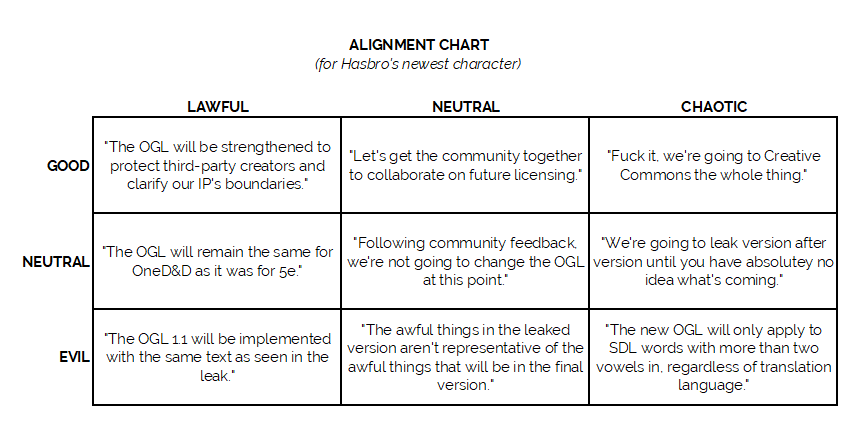
Bree-Yark!
This is a repost promoting content originally published elsewhere. See more things Dan's reposted.
JTA tweeted a brilliant thread about something he discovered while digging through old D&D texts, and it’s awesome so – as I imagine he wouldn’t mind – I’ve reproduced it in full here:
I don’t really Twitter so much these days because like most social media it makes me either gloomy or extremely grumpy with the state of the world, but since I also lack the time to bother blogging anywhere, here’s a ludicrously nerdy thread about a Dungeons & Dragons rumour.So, back in the days of AD&D 1st Edition your printed modules would often come with a table of Rumours. The idea was hearing rumours increased the depth of the world, so players didn’t feel like NPCs just winked into existence when they entered the Hydra’s Den tavern & said “hi”.
But sometimes the rumours would be false, or exaggerated. That also added depth and had the bonus of ensuring that players didn’t take it for granted. OK, this guy in the red robe *says* Kobolds are poisoning the iron ore, but is that at all plausible, or is it just a bad seam?
(Those of us without any friends, or at least without friends equally into D&D in the 80s & 90s, also got this experience because it was well-replicated in the TSR Gold Box series of games, either in-game, or more-commonly through supplementary material in the boxes.
The supplementary materials often came in a separate “Journal” supplied in the box, & were a sort of additional layer of copy-protection because if the Game says “read Entry 19”, your choice is either do so, or wait 25 years for the abandonware PDFs to hit archive.org.
e.g., here’s the Traveller’s Tales from ‘Curse of the Azure Bonds’: note the subtlety of entries 1 and 8, about the Princess, sounding corroborative – maybe encouraging the party to more deference around someone with purple in their clothes, though either or both might be false.)
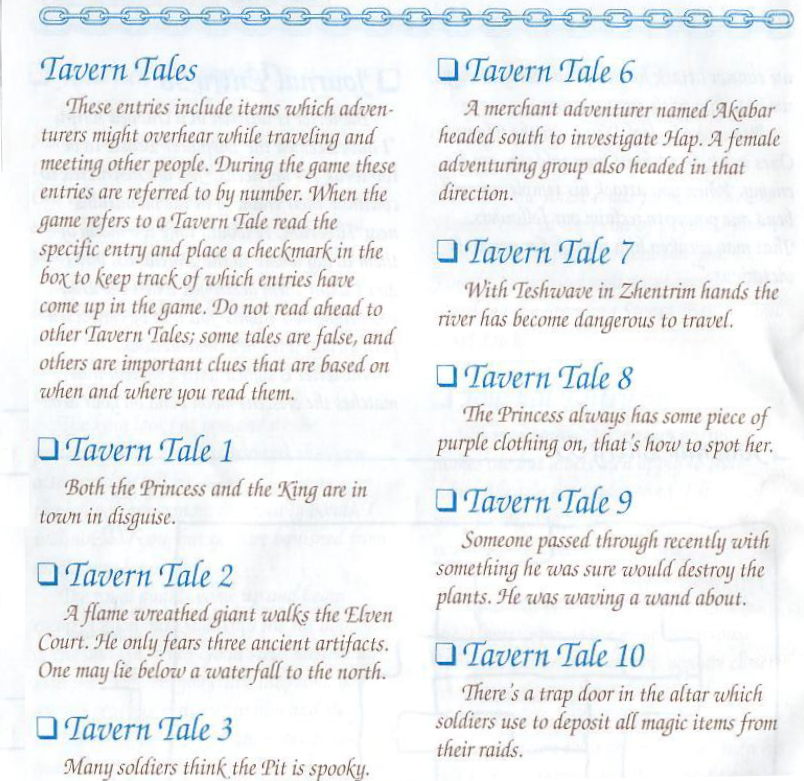
Anyway, this only really existed in the TSR/SSI games because it was in the standard modules.
I was reminded of the rumour system when I was digging back into AD&D Module B2: The Keep on the Borderlands to borrow a bunch of content for a campaign I’ve just inherited (as you do)
‘Keep on the Borderlands’ was by Gary Gygax himself, and suffers a bunch from the typical issues 1e had, none of which I’ll address here because I would please nobody. But the rumours table is a really good example of the type – it gives players depth but not unfair advantages.
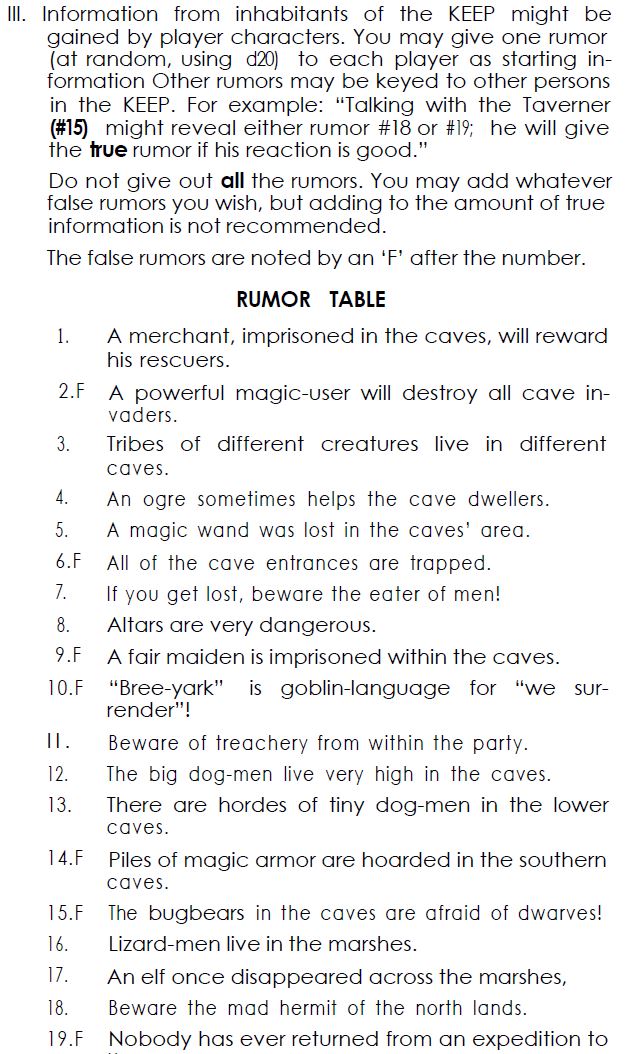
Now Keep on the Borderlands was a pretty big deal of a module back in the day. It was module B2, of the Basic Set, & it did some stuff really well, especially for new players – sort of a 1980 equivalent of ‘Lost Mine of Phandelver’ today. Lots of players cut their teeth on it.
Rumour 10 – ‘”Bree-Yark” is goblin-language for “we surrender”!’ – is a false rumour, though the party doesn’t know that: whatever ‘Bree-yark’ means, it’s not “We Surrender”.
In fact, the module tells the DM it means “Hey, rube!!” and is used by goblins to sound the alarm.
(Spoilers here for the Goblin Lair in Location D of the Caves of Chaos, but when goblins on watch call out “Bree-yark!”, more goblins at #18 will bribe an ogre to come help attack the party. (1e often imposed dynamic worlds by fiat, back when the world was young, the DMs green)
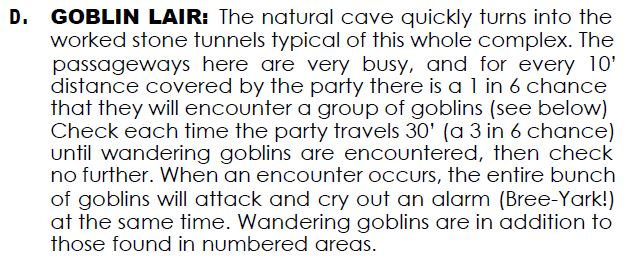
So lots of early DMs got to imagine the potential hilarity of the party arriving in the cave, hearing goblins apparently surrendering, & dropping their guard, never realising life just got harder!
(It isn’t much hilarity, but in the 80s, as now, there was limited scope for joy)
Still – it’s a decent joke. Everyone believes “Bree-yark” is Goblin for surrender, but it isn’t really, that’s just a false rumour, spread by boastful drunks who’ve never seen a goblin in real life anyway.
So much for 1st Edition AD&D, I guess.
…except:
It’s 2014. The wheel of time turns, ages come and pass, and Grapple rules don’t so much become legend as “remain completely incomprehensible”. Now every new adventurer carries a Field Marshall’s baton in their knapsack, ‘cos tracking encumbrance is for chumps, & D&D 5e launches.
(While I’m doing archaeology, take a moment in this fast-forward to enjoy the glorious madness of the Grimtooth’s Traps series, which popped up in ’81 & features brilliantly inventive nastiness to spring on players who aren’t too attached to their character sheets. Or friends.)
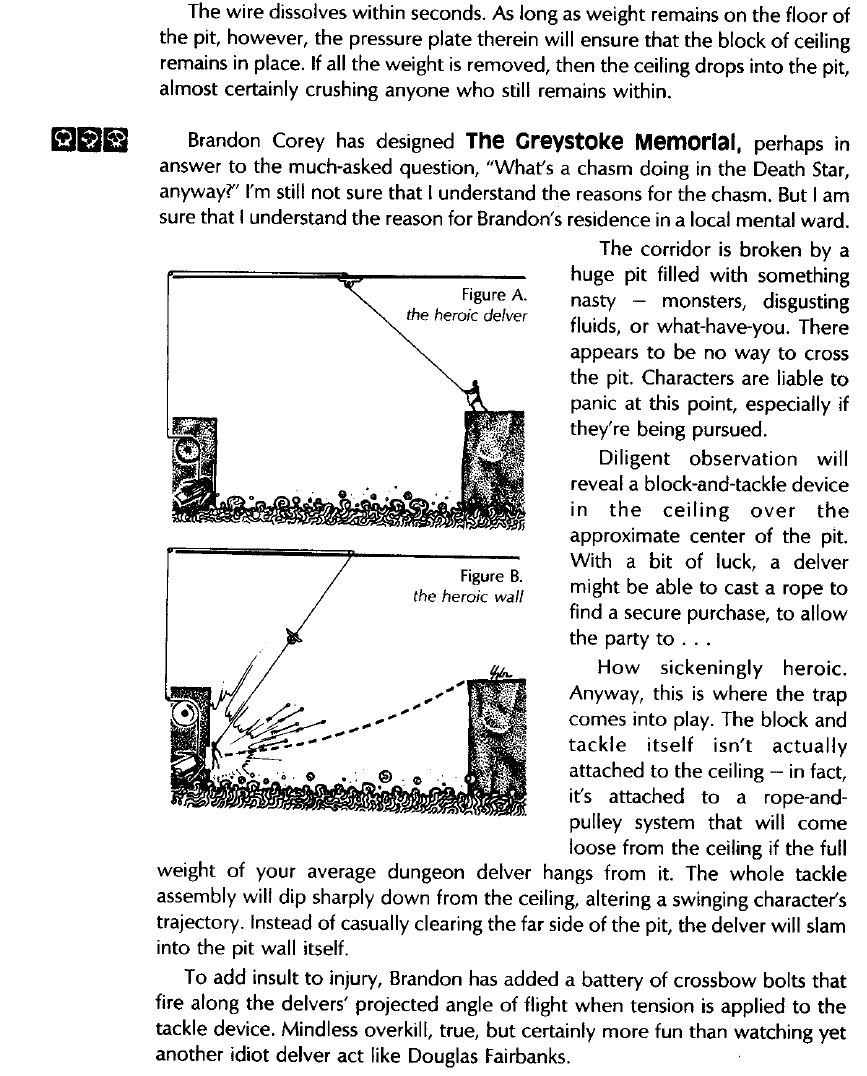
So, 5e launches, to a lot of stick in some circles (I never knew a version of D&D that didn’t: probably some wazzock in 1971 ranted that the codified Fantasy Supplement rules in ‘Chainmail’ “beTraYs rEaL FaNs!” and sold out the hobby, but at least they couldn’t whinge on Reddit)
…but someone involved in 5e is has conjured the most obscurely brilliant bit of ultra-specific nerd humour I have seen in years.
Y’see, 5e modules don’t really do Rumour Tables or “If the party X, then Y, else Z” – DMs create dynamic worlds on the fly. (Hopefully).
So you’d think there’s no more chance of hilarious moments where the Goblins start yelling “Bree-Yark!” and Magnus Rushes In only to be shocked to find a well-bribed and high-Challenge Rating ogre running obediently up from Location E.22.
But you would think (slightly) wrong.
Because although 5e modules don’t do rumours the like 1e did, the Monster Manual does do flavour text – it’s usually a snippet of lore, or a word from a famous scholar, or advice from an adventurer who encountered the monster but lived to tell the tale. It provides fluffy depth.
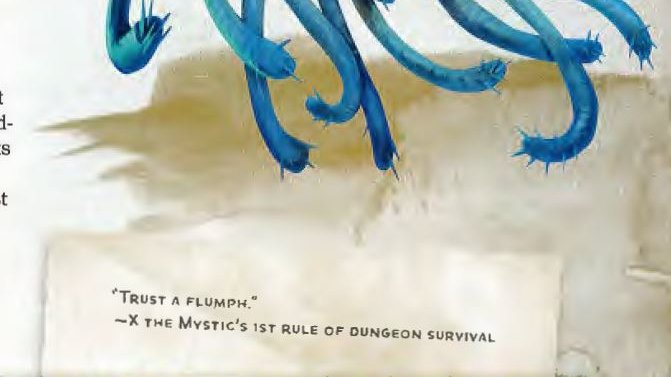
And, actually, I say “it’s usually” but I’ve just checked and every bit of flavourtext I can find in the Monster Manual is either By A Scholar, From a Book, An Adventurer’s Tale, or a Monster Describing Itself…
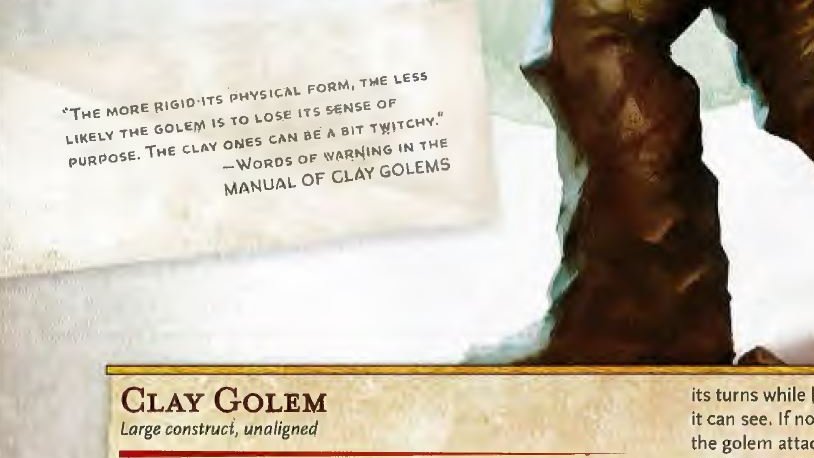
…with one single exception: the flavourtext on the entry for Goblins, which isn’t attributed to anybody or anything, but is just the claim that “Bree-Yark!” means “we surrender!”
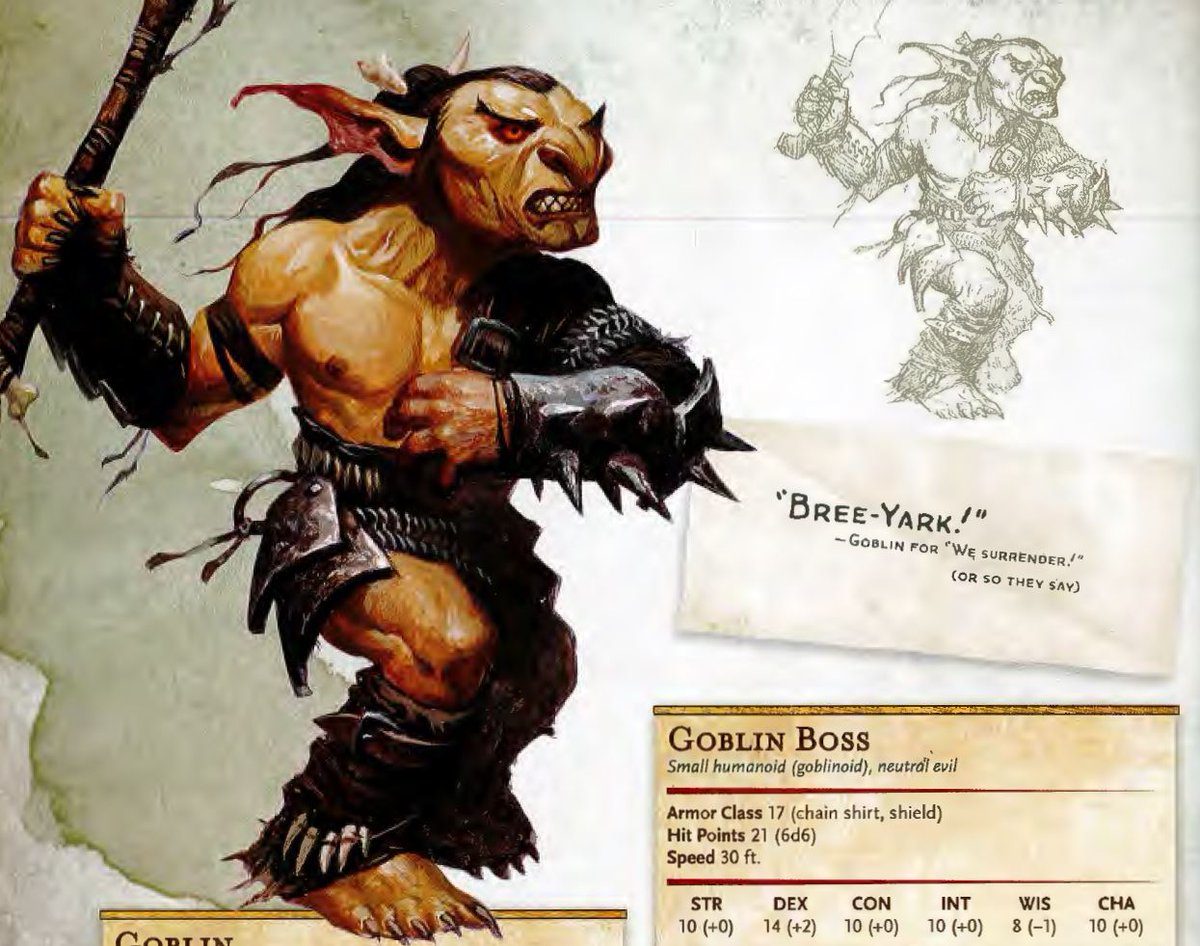
This isn’t attributed to any source. Nobody in-lore has a citation for this. It’s just something “they say”. A genuine 1st Edition rumour just chilling out in the 5th edition Monster Manual three decades after B2 landed.
Glorious. Well played, @Wizards. Very well played.
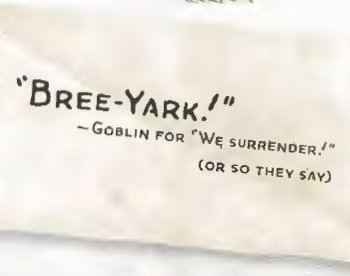
Printing Maps from Dungeondraft
I really love Dungeondraft, an RPG battle map generator. It’s got great compatibility with online platforms like Foundry VTT and Roll20, but if you’re looking to make maps for tabletop play, there’s a few tips I can share:
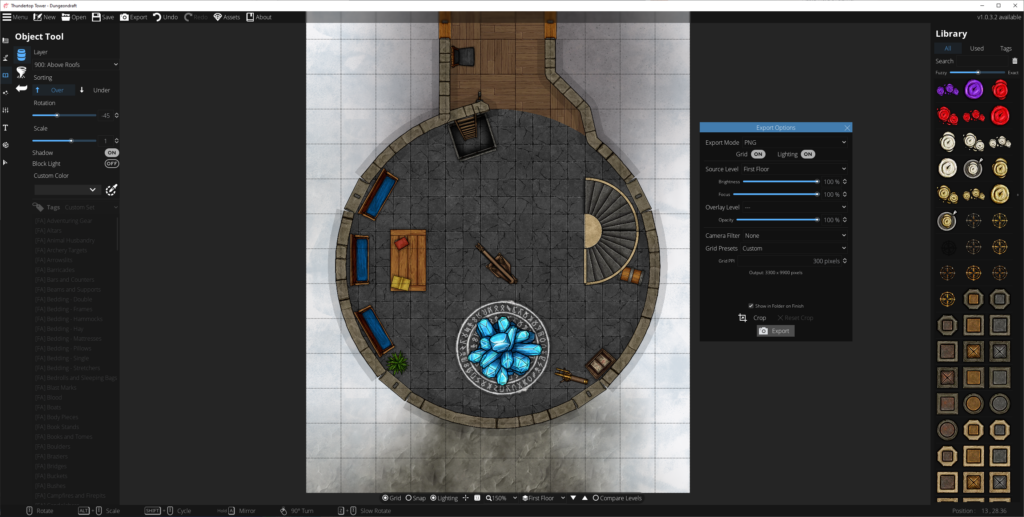
Planning and designing
Dungeondraft has (or can be extended with) features to support light levels and shadow-casting obstructions, openable doors and windows, line-of sight etc… great to have when you’re building for Internet-enabled tabletops, but pointless when you’re planning to print out your map! Instead:
- Think about scale: I’m printing to A4 sheets and using inch-size squares, so every 11 x 8 squares equates to one sheet of paper. Knowing this, I can multiply-up to a whole number of sheets of paper and this informs my decisions about how to best make use of the maps (and what will and won’t fit on my dining table!).
- Focus on legibility: Your printer probably won’t have the same kind of resolution as your screen, and your players can’t “zoom in” to get details. Play with the grid styles (under Map Settings) to find what works best for you, and try not to clash with your floor patterns. If you’re printing in monochrome, use the “Printer-Friendly” camera filter (also under Map Settings, or in the Export Options dialog) to convert to gorgeous line-art. Make sure critical elements have sufficient contrast that they’ll stand out when printed or your players might walk right over that chest, campfire, or bookshelf.
- Think about exposure: You don’t get digital “fog of war” on the tabletop! Think about how you’re going to reveal the map to your players: plan to print in multiple sections to put together, jigsaw style, or have card to “cover” bits of the map. Think about how the tool can help you here: e.g. if you’ve got multiple buildings the players can explore, use a higher “level” or roof layer to put roofs on your buildings, then print the relevant parts of that level separately: now you’ve got a thematic cover-up that you can remove to show the insides of the building. Go the other way around for secret doors: print the empty wall on your main map (so players can’t infer the location of the secret door by the inclusion of a cover-up) and the secret door/passage on the overlay, so you can stick it onto the map when they find it.
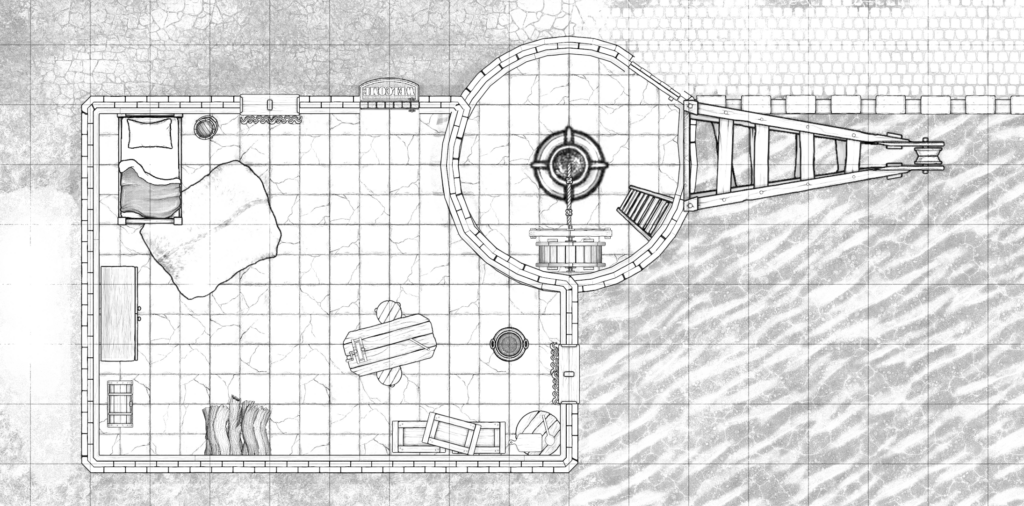
Printing it out
There’s no “print” option in Dungeondraft, so – especially if your map spans multiple “pages” – you’ll need a multi-step process to printing it out. With a little practice, it’s not too hard or time-consuming, though:

Export your map (level by level) from Dungeondraft as PNG files. The default settings are fine, but pay attention to the “Overlay level” setting if you’re using smart or complex cover-ups as described above.
To easily spread your map across multiple pages, you’ll need to convert it to a PDF. I’m using Gimp to do this. Simply open the PNG in Gimp, make any post-processing/last minute changes that you couldn’t manage in Dungeondraft, then click File >
Export As… and change the filename to have a .pdf extension. You could print directly from Gimp, but in my experience PDF reader software does a much better job at multi-page printing.

Open your PDF in an appropriate reader application with good print management. I’m using Foxit, which is… okay? Print it, selecting “tile large pages” to tell it to print across multiple sheets. Assuming you’ve produced a map an appropriate size for your printer’s margins, your preview should be perfect. If not, you can get away with reducing the zoom level by up to a percent or two without causing trouble for your miniatures. If you’d like the page breaks to occur at specific places (for exposure/reveal reasons), go back to Gimp and pad one side of the image by increasing the canvas size.
Check the level of “overlap” specified: I like to keep mine low and use the print margins as the overlapping part of my maps when I tape them together, but you’ll want to see how your printer behaves and adapt accordingly.

If you’re sticking together multiple pages to make a single large map, trim off the bottom and right margins of each page: if you printed with cut marks, this is easy enough even without a guillotine. Then tape them together on the underside, taking care to line-up the features on the map (it’s not just your players who’ll appreciate a good, visible grid: it’s useful when lining-up your printouts to stick, too!).
I keep my maps rolled-up in a box. If you do this too, just be ready with some paperweights to keep the edges from curling when you unfurl them across your gaming table. Or cut into separate rooms and mount to stiff card for that “jigsaw” effect! Whatever works best for you!

DNDle (Wordle, but with D&D monster stats)
Don’t have time to read? Just start playing:
There’s a Wordle clone for everybody
Am I too late to get onto the “making Wordle clones” bandwagon? Probably; there are quite a few now, including:
- Hundreds of different languages,
- Entirely different word sets (swear words, slang, bird banding codes, posix commands, common passwords…),
- Different games in the same style (absurdle plays adversarially like my cheating hangman game, crosswordle involves reverse-engineering a wordle colour grid into a crossword, heardle is like Wordle but sounding out words using the IPA…)
- Twists on the idea (try guessing prime numbers, equations, countries, chess openings, chords, or the composition of parties of fantasy adventurers…)
- Just plain silly ones (horsle, easy wordle, chortle…)

Now, a Wordle clone for D&D players!
But you know what hasn’t been seen before today? A Wordle clone where you have to guess a creature from the Dungeons & Dragons (5e) Monster Manual by putting numeric values into a character sheet (STR, DEX, CON, INT, WIS, CHA):

What are you waiting for: go give DNDle a try (I pronounce it “dindle”, but you can pronounce it however you like). A new monster appears at 10:00 UTC each day.
And because it’s me, of course it’s open source and works offline.
The boring techy bit
- Like Wordle, everything happens in your browser: this is a “backendless” web application.
- I’ve used ReefJS for state management, because I wanted something I could throw together quickly but I didn’t want to drown myself (or my players) in a heavyweight monster library. If you’ve not used Reef before, you should give it a go: it’s basically like React but a tenth of the footprint.
- A cache-first/background-updating service worker means that it can run completely offline: you can install it to your homescreen in the same way as Wordle, but once you’ve visited it once it can work indefinitely even if you never go online again.
- I don’t like to use a buildchain that’s any more-complicated than is absolutely necessary, so the only development dependency is rollup. It
resolves my
importstatements and bundles a single JS file for the browser.
Which D&D Character Are You?
I Am A: Chaotic Neutral Elf Mage Druid
Alignment: Chaotic Neutral characters are unstable, and frequently insane. They believe in disorder first and foremost, and will thus strive for that disorder in
everything they do. This means that they will do whatever seems ‘fun’ or ‘novel’ at any given time.
Race: Elves are the eldest of all races, although they are generally a bit smaller than humans. They are generally well-cultured, artistic, easy-going, and because of
their long lives, unconcerned with day-to-day activities that other races frequently concern themselves with. Elves are, effectively, immortal, although they can be killed. After a
thousand years or so, they simply pass on to the next plane of existance.
Primary Class: Mages harness the magical energies for their own use. Spells, spell books, and long hours in the library are their loves. While often not physically
strong, their mental talents can make up for this.
Secondary Class: Druids are a special variety of Cleric who serves the Earth, and can call upon the power in the earth to accomplish their goals. They tend to be
somewhat fanatical about defending natural settings. (could equally be secondary class: Bard)
Deity: Azuth is the Lawful Neutral god of wizards and mages. He is also known as the High One, and is the Patron of Wizards. His followers believe that a systematic
approach to magic is the best, and they strive for calm and caution in order to avoid accidents. They wear shimmering robes, and are well-versed in magic, as well as typical priest
spells. Azuth’s symbol is a hand with a raised, glowing index finger.
I still loathe D&D.

